10 DJ MARKETING IN STEPS A PRIMER: AI TOOLS FOR DJS

FESTIVAL SCENES EDC LAS VEGAS MOVEMENT DETROIT
MAU P


CHARLES D/MIKE MACALUSO ECHOSTORMS
SERATO STUDIO 2.0
PIONEER DJ DJM-A9
NYC’S SILO CLUB
Stardom & The Otherside




10 DJ MARKETING IN STEPS A PRIMER: AI TOOLS FOR DJS

FESTIVAL SCENES EDC LAS VEGAS MOVEMENT DETROIT
MAU P


CHARLES D/MIKE MACALUSO ECHOSTORMS
SERATO STUDIO 2.0
PIONEER DJ DJM-A9
NYC’S SILO CLUB
Stardom & The Otherside



Atlantic City, N.J. – Set for August 7-10 at the Hard Rock Hotel & Casino in Atlantic City, N.J., DJX will bring the entire DJ industry together with its winning combo of new technologies, education, and sponsored After Dark events.


Produced by DJ LIFE magazine and Hazan Media Group, DJX will present a showfloor full of the latest DJ-related products (audio, lighting, studio, accessories, etc.), a slate of 30plus seminars, panels, and keynotes tackling the latest vital topics, and nightly parties featuring top DJ talent. Operating since 1990, DJX is the longest-running and most-impactful trade show/event in the North American DJ industry. Whether you’re a mobile jock, club DJ, bedroom spinner or home-studio music maker, DJX ’23 will have something for you.
For Starters: DJX’23 will kick off its After Dark series of evening events by presenting Grammy-Award-winning DJ/producer/ artist Dave Audé at the HQ2 Nightclub at the Ocean Casino Resort on Monday, Aug. 7. Additionally, the prolific talent will participate in a special DJX “Keynote Q&A” back at the Hard Rock on the following day, Tuesday, Aug. 8.
By his own estimation, DJ/producer Audé has made more than 1,500 remixes. By the record book, he’s created 135 No. 1 Billboard Dance tracks – more than any remixer in history. He’s worked on songs from the very biggest acts in the pop, rock, country, dance, R&B, and hip-hop genres – from Madonna to U2 and everyone in between… Adele, Lizzo, Lady Gaga and so many more. In addition to several Grammy-Award nominations, he earned his award in 2016 for his remix of “Uptown Funk” by Mark Ronson feat. Bruno Mars. It’s been quite a career so far, and Audé will put his talents on display and discuss his amazing journey at DJX ’23.
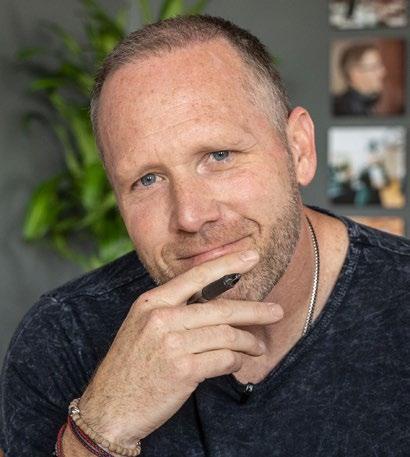

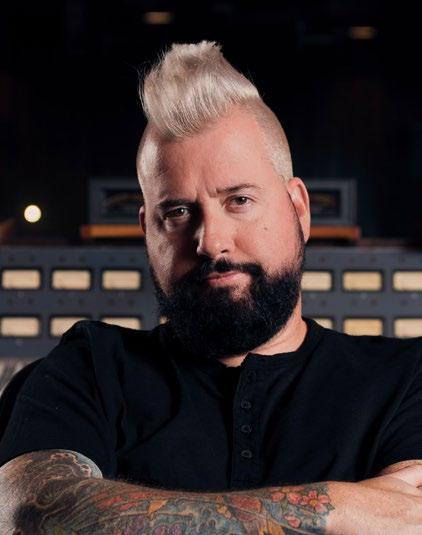
Other Seminar Highlights: Looking for the next phase in social media? Twitch Partner DJ Cova has answers and he’ll examine what it all means for DJs in his session, “Gig Vlogs: The Ultimate Guide to Growing Your DJ Business.” Featuring a panel of top DJ/influencers like Cleveland Terry, Nick Spinelli, and DJ Barr, the seminar will explain how to document your events via socials, but also how to build your brand through vlogging.
Speaking of branding… in her detail-rich tutorial, “Be Yourself: A Guide to Building Your Personal Brand,” Connecticut-based DJ Stephanie Rivkin will show DJs why personalizing your brand is part of a powerful strategy to attract your ideal client. She’ll show how building your personal brand enables you to build trust, stand out from competitors, boost brand awareness, and increase conversion rates. If you want success, it’s up to you to build that brand. In the end, she’ll explain how to showcase the real you.
For mobile DJs looking to gain useful, money-making ideas that they can take back to their markets, DJX presents “The DJ’s Vault Live: Pro Tips from the Pros.” Moderated by Joe Bunn of the North Carolina-based Bunn DJ Company, this session will include a pair of New Jersey-based industry OGs – Mike Walter of Elite Entertainment and Jason Jani of SCE Event Group –who will discuss marketing, selling, hiring, training, performance and more. How did these guys climb the ladder and how do they stay on top? Bring your questions and prepare to be enlightened.
For more on DJX ’23, please visit Page 8; for the very latest on the show, please visit www.djxshow.com.
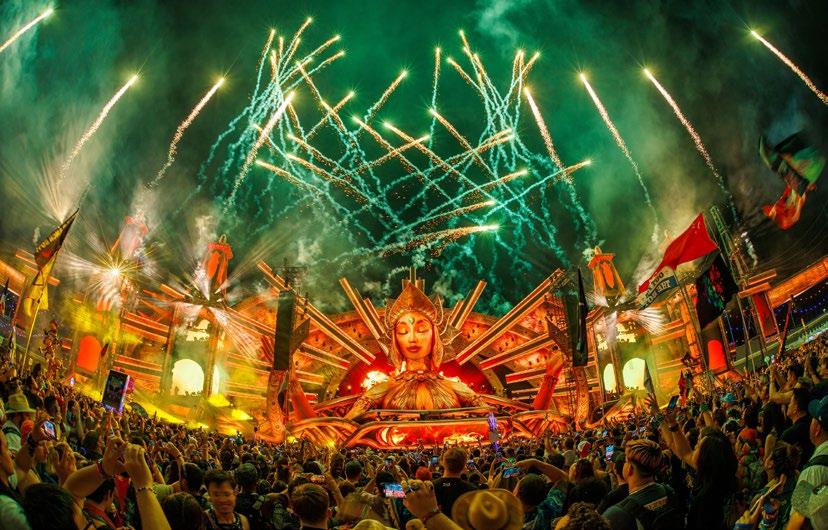

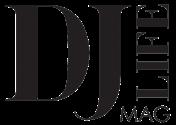
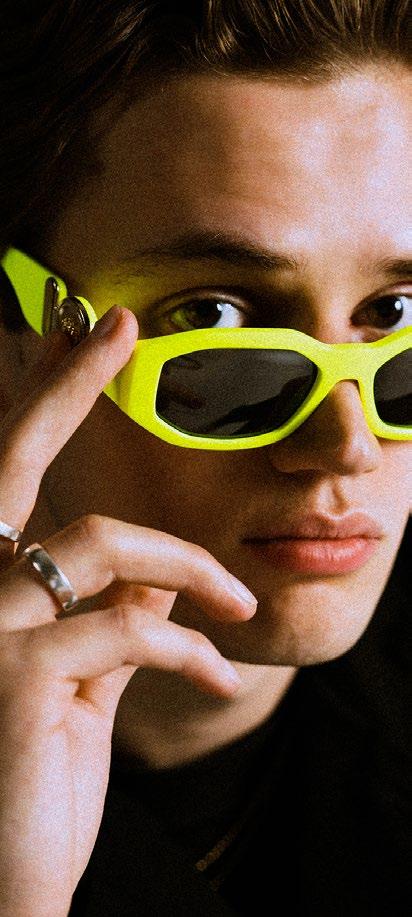

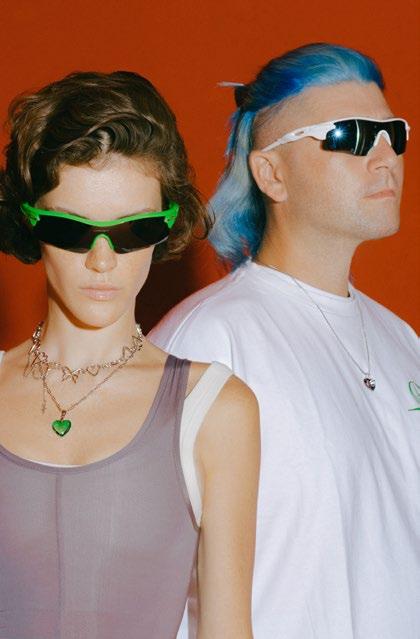


40 Playback Pioneer DJ DJM-A9
42 Studio Session Serato Studio 2.0
54 Tracks

In the electronic-dance-music world, stardom can be a relative notion. A DJ/producer can become a big deal quickly with a hit record or two – but can that momentum be sustained? What’s the next move to help ensure a successful career?
After hitting it big in 2021 with “Do It To It” and then again the next year with “Believe,” these are the questions that have confronted ACRAZE, who recently released his new single, “The Otherside.” So, in this issue, our Mark Mancino connected with the Orlando, Fla.-based talent to get these answers, but also to tell the story of the 27-year-old Charlie Duncker and how he hit it big in the first place.
Also, in this issue, we visit two of EDM’s more prominent festivals – Las Vegas’ Electric Daisy Carnival and Detroit’s Movement. Held this past May 19-21, EDC Vegas drew more than a half-million people over its three days to see most of EDM’s biggest stars. Movement, as always, was a more esoteric affair, as it drew about 90,000 fans over this past Memorial Day weekend to hear a more tightly curated lineup of mostly techno and house acts. As always, the pics from both festivals are spectacular.
In our Sound Bites section, our Mr. Mancino offers double duty as he visits with up-andcoming hitmaker Mau P, he of “Drugs from Amsterdam” fame. For the In the Studio portion of the department, we connect two remixer/producers – Charles D and Mike Macaluso – to discuss “The Final Chapter,” Macaluso’s 1999 prog-house club hit that was recently given a techno rerub by Charles D for the prestigious Drumcode label. Also, in this issue, we interview EchoStorms, an electronic duo consisting of Brit Ben Locke and Russian Katya Fadeeva, who have been making noise in clubland from their current home in Bali, Indonesia.
For Club Spotlight, we visited Brooklyn’s Silo, which somehow packs a top-end soundlighting-and-video system into a military-style Quonset hut – and it’s quite a late-night spot. And in our gear-review columns, we handle two exciting new products for the DJ market. In Playback, Wesley King reviews Pioneer DJ’s new DJM-A9 mixer. Meanwhile, in Studio Session, DJ Deets takes on Serato’s Studio 2.0.
For the mobile jock, Joshua Volpe’s Business Line entry explains how DJs can successfully market in 10 basic steps. In our Mobile DJ Profile, we connect with Sounds of Jersey’s Xavier Powell, who explains how his aggressive approach works in his market. And in his regular feature, Jordan St. Jacques previews one of his upcoming DJX seminars by offering a primer on AI tools that DJs can use.
Speaking of DJX, we preview the upcoming show in our News section and give a look at the event’s sponsored-seminar slate in Feedback. Accordingly, we hope to see you all at DJX, which is set for Aug. 7-10 at the Hard Rock Hotel & Casino in Atlantic City, N.J. Produced by DJ LIFE , DJX will offer an exhibit hall full of the latest gear, 30-plus educational seminars, and sponsored After Dark events. Don’t miss it.
editor-in-chief
Jim Tremayne jtremayne@hazanmediagroup.com
editor-at-large
Brian O’Connor boconnor@@hazanmediagroup.com
web editor and social media manager
Mark Mancino mmancino@@hazanmediagroup.com
contributors
Wesley King, Chris Caruso, Amanda Chavez, Shawn Christopher, Paul Dailey, Reed Dailey, Chris Davis, DJ Deets, Tony Fernandez, Tommy D Funk, Lexi Ferguson. Ryan Hayes, Greg Hollmann, Erik Miller, Lily Moayeri, Jordan St Jacques, Jeff Stiles, Ashley Teffer, Danny Turner, Phil Turnipseed, Joshua Volpe, Travis Wackerly, Curtis Zack
chart coordinator
Dan Miller dmiller@hazanmediagroup.com
national sales manager
Josh Kerman jkerman@hazanmediagroup.com

creative director
Janice Pupelis jpupelis@hazanmediagroup.com
director of technologies and project management
Steve Thorakos sthorakos@hazanmediagroup.com
Chairperson & COO/Co-Publisher
Robin Hazan rhazan@hazanmediagroup.com
President & CEO/Co-Publisher
Shawn Hazan shazan@hazanmediagroup.com

visit
516.767.2505
Editorial and Sales Office: DJ Life, Oyster Bay, NY 11771. (516) 767-2505 • (Sales/all other business): (516) 767-2505 • djlife@hazanmediagroup.com.
Editorial contributions should be addressed to The Editor, DJ Life Mag, Oyster Bay, NY 11771 or sent to JTremayne@hazanmediagroup.com.

DJ Life Mag is published bi-monthly starting with the second month annually.
Design and Contents: copyright © 2023 by DJ Life Mag and must not be reproduced in any manner except by permission of the publisher.
Web: DJLifeMag.com DJXShow.com and HazanMediaGroup.com
Subscriptions: Complimentary Digital Edition. Email: djlifemag@hazanmediagroup.com Phone: 516-767-2505 ext. 502 Web: djlifemag.com/subscribe

Atlantic City, N.J. – Each August at DJX, the world of DJs –mobile, club, studio – convenes for four days of networking, education, inspiration – and some fun. The show’s exhibit hall is the DJ industry’s largest and the companies that support DJX on the showfloor also sponsor a slate of info-filled seminars.
At DJX ’23 – set for August 7-10 at the Hard Rock Hotel & Casino in Atlantic City, N.J. – show sponsors will present seminars offering looks at hardware, software, and business services. The sponsored seminar schedule at presstime includes:

SMPL System Session: Help Optimize Your DJ Operations. SMPL System is a CRM & e-marketing platform built specifically for the events industry. At this seminar for pro DJs/event MCs, SMPL System will demonstrate ways to make the most of your time and resources, as well as present tools that will enable your team to increase efficiency in the workplace. Participants will learn strategies to help manage their time and create productive habits.
This session will also demonstrate the power of SMPL System, the advanced workflow automation platform designed to streamline processes and increase efficiency by eliminating manual and repetitive tasks. The product helps businesses capture, organize, and control all of their information, allowing for greater visibility and control to improve their communication flow and predictability.
The Unfair Advantage: Behind the Scenes on How These DJs Are Crushing the Competition… presented by Vibo. Vibo is an
event-planning software that communicates client needs to the DJ in one user-friendly dashboard. At DJX ’23, Vibo will present the real stories about how DJs are making brides want to book only them and look no further. The one thing they have in common is their “unfair advantage” – and that secret is Vibo. In this live panel, Brian S Redd, DJ Rachel, Rick Web, Aaron Strawn, and Jay Murch will discuss how Vibo became the secret sauce that separates them from DJs who aren’t using it. Vibo is designed to give your clients a less stressful and more customized event-planning experience and help you the DJ organize your music to throw better events, so you can focus on your business and increase your bottom line.
Lighting? Easy! How New Lighting Tech Can Take Your Business from Pitfalls to Profits… presented by CHAUVET DJ. CHAUVET DJ is taking the mystery out of creating powerful event lighting through cutting-edge technology, giving DJs the ability to create jaw-dropping looks quickly, easily, and wirelessly. Incredible and profitable lighting has never been easier. In this sponsored session, discover new tech, learn how to turn common lighting pitfalls into profits, and get inspired to make more money with lighting. Because time really is money. But how much time equals how much money? Find out in this enlightening seminar from CHAUVET DJ.
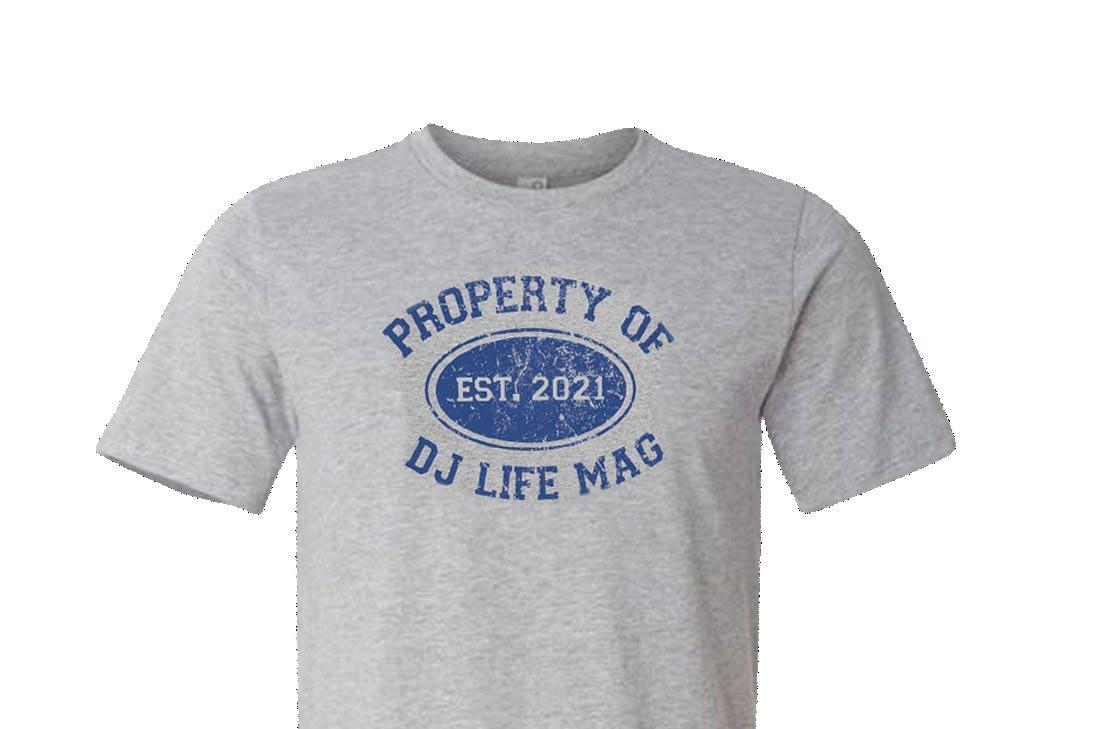
$20
Small, Medium, Large, XL and XXL Plus shipping
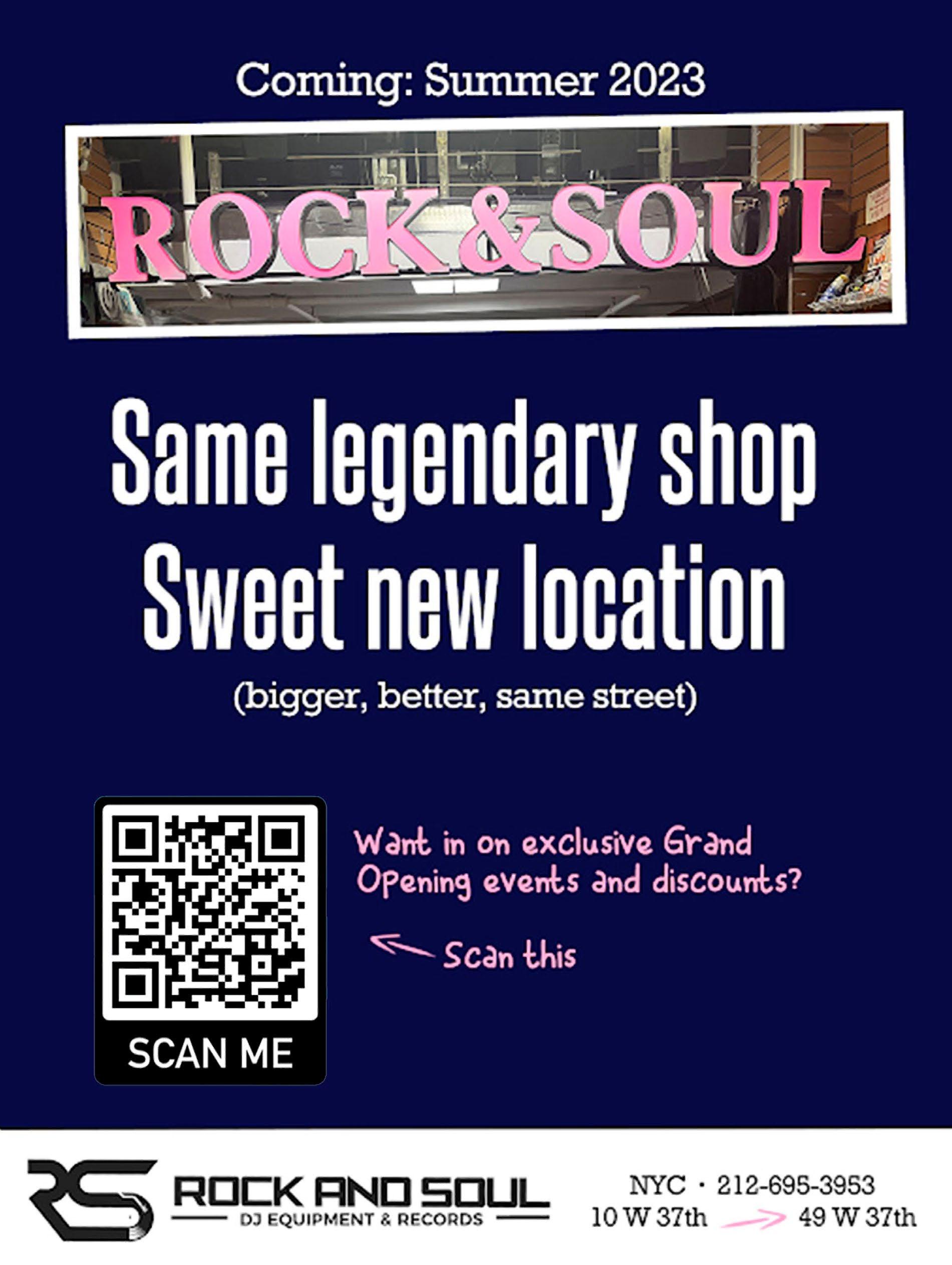
The past year has been very good one for Mau P, especially in the time since August 2022 when his ultra-cheeky, tech-house anthem “Drugs from Amsterdam” began to make big waves.

Since that breakout track, the Dutch DJ/producer has continued to enjoy a surge of popularity, mainly because he’s continued to deliver dancefloorscorching tracks. He followed up in January with another manic cut, the infectious “Gimme That Bounce,” and how he’s back with the saucy single, “Your Mind Is Dirty” on John Summit’s Off The Grid records.
While Maurits Westveen, 27, may not be new to the dancemusic industry, this is the first time he’s enjoyed a real taste of global success and genuine buzz around his Mau P moniker – and he’s making the most of it all. In addition to playing high-profile club and festival gigs, he also landed an official remix for Calvin Harris and Ellie Goulding’s smash, “Miracle.” Things continue to look up.
DJ LIFE recently caught up with Mau P to discuss his creative process, his gear in the DJ booth, and his sharp career ascent.
DJ LIFE: How and when did you begin exploring electronic music?
Mau P : I think I got into electronic music at a really young age. My sister and I found these CDs somewhere with the biggest Euro-dance hits of the moment, like Scooter and such. We used to play that all the time and bounce around and dance to it as little kids. Then, later on, I got into GarageBand on the computer and started messing around with
all the dance loops it had. Eventually, I found out about the Swedish House Mafia and Skrillex, and then little Mau knew what he wanted to do in life, I guess.
DJ LIFE: Which sound would you say you initially gravitated towards? What styles of dance music do you prefer to listen to on your own time?
Mau P : I feel like I was into everything back then. I was into electro, dubstep, progressive house, moombahton, drum-n-bass, you name it! Right now, if I listen to dance music on my own time, I listen to a lot of old soulful house.
DJ LIFE: How about when you aren’t listening to dance music? Any artists that you love? Is there a dream collaborator?
Mau P : I listen to a lot of older jazz, R&B, and soul music, like Sade, Bobby Caldwell, Stevie Wonder, Steely Dan, etc. I’d actually love to hear what Sade sounds like on a house song!
DJ LIFE: Did you expect “Drugs From Amsterdam” to become as well-received as it has? What was the process behind it?
Mau P : No, not at all. I was hoping it could get me in the right direction and connect me to some cool names in the industry, but I never expected it to turn my whole life upside down the way it did. The song actually started out as a really simple idea I had for the vocal hook and the main melody. I just went from there, and then the song sort of produced itself. I mean, don’t get me wrong – I worked on a lot of details and made very difficult choices for the arrangement, but it did all go really smooth. I think I worked on the demo for two weeks before getting MC Stretch in to replace
my vocals, so I could finish it.
DJ LIFE: Tell us about your new single, “Your Mind Is Dirty.” What’s the reaction been when you play it out?

Mau P : This record is actually so funny. It’s awkward, it’s banging, it makes people shy, and it also makes them wild out. The reaction has been amazing from the first time I ever played it, and it’s now a big moment in every set for sure!
DJ LIFE: Is there a story behind it?
Mau P: One day I woke up and I had this idea of using the sound of people having sex as a buildup for a song. So, I started to experiment with it in the studio. I combined a bit heavier Mau P techno sound with a girl moaning louder and louder until she reaches orgasm. I love how people get triggered by it. At first, it was a little awkward on the dancefloor when I played it, but after a few times we have all given in and it feels like the song has broken another boundary.
DJ LIFE: This past March, you were pretty busy during Miami Music Week. Any standout moments?
Mau P : This year was so much fun because it was my first time attending as Mau P and the first time since “Drugs From Amsterdam” came out. I love the energy and the passion for dance music that you can feel during the week. Probably the biggest moment was playing Elrow at Factory Town and also a meteor shower flying over the crowd at Afterlife while Tale Of Us played one of my unreleased songs!
DJ LIFE: When you’re DJing, what’s a typical set-up for you?
Mau P : I have fully converted to a Pioneer DJ DJM-V10 mixer now and almost can’t play on a DJM-900 anymore. I think my style of DJing changed a bit, too, when I got familiar with the V10. I also always play with a Pioneer DJ RMX-1000, which just gives you so much more room to get creative and freestyle during the set. Then, finally, of course, there’s at least two of the latest CDJs, but I prefer four, so that I can mix acappellas in as well.
DJ LIFE: Describe your current studio setup or the “perfect” studio setup?
Mau P : My current studio set-up is pretty much just my laptop. I can create tracks start-to-finish entirely on the road, but whenever I’m in Amsterdam I do like to go to my studio to check out my mix. I, personally, strongly believe it’s not so much about the set-up, but more about the ideas. I like to restrict myself and not have the best sound or the best gear at my disposal sometimes because it boosts creativity.
DJ LIFE: Do you have any pre-show or studio routines or rituals?
Mau P: I don’t really have a pre-studio routine, but I do get very superstitious before every show. It can literally be with anything, like if I don’t wear the right socks I feel like the show might not be as good as I want it to be. It’s sort of stupid, but also keeps me on edge [laughs].
DJ LIFE: For those just getting started in the scene, what are some pros and cons you can share with the aspiring DJ/producer who thinks they’ve got what it takes to pursue a career in music?
Mau P : The biggest pro about a career in music is that it will never feel like work. You make money doing something that you really love and are really passionate about. The biggest con is that you have to make a really, really big time investment. A lot of people want the insane lifestyle they see DJs have on Instagram, but not everybody wants to work for it. I mean, I’ve been broke, lost in my career, creatively exhausted, you name it… but I never gave up – and that’s how I ended up where I am now. Took me, like, 10 years, though.
DJ LIFE: Given your recent rise to notoriety, where do you see your career in five years?
Mau P: I want to be able to do bigger solo shows, set up a brand surrounding those events, start a clothing line, release boundary-pushing songs, shake things up, start a label, help other upcoming producers, enjoy life, and get some sleep every now and then.
– Mark MancinoNot every producer gets to remix a classic track that helped shape his sound. But this very thing happened for rising DJ/producer Charles D, who recently added a modern techno touch to Mike Macaluso’s 1999 underground smash, “The Final Chapter,” and released it on the prestigious Drumcode label.
Considered to be one of the greatest New York City club anthems of all time, “The Final Chapter” helped define an era in Gotham clubland when the progressive sound ruled the dancefloors of its many cavernous venues, like Exit, Tunnel, and Limelight. And now Charles D (aka Calogero LoBrutto) is bringing his take to the techno crowd.
Off the back of the remix, the two New York area DJ/producers met in person for the first time to discuss the making of the legendary track, the legacy that surrounds it, and the club culture that created it.

Charles D: Hey Mike, it’s a pleasure to meet you finally in person. For me, it’s always a surreal moment when I get to meet an artist that has personally had an impact on my life as an artist. Your record “Final Chapter” was a big part of the soundtrack of NYC nightlife in the late 1990s and early-tomid 2000s. At that time, iconic nightclubs such as Sound Factory, Avalon, Tunnel, and Pacha were thriving in the local scene, and “Final Chapter” was being played every weekend for years – even until I started going out to nightclubs myself in 2005. Take me back to the beginning… at what point of your career did “Final Chapter” come along?
Mike Macaluso: Thank you Charles for your kind words, I appreciate it. You are super-talented and I look forward to hearing more of your music in the future. I made the “Final Chapter” in 1998-99, if my memory serves me right. I had just released a few records under the name Revelation on Groovilicious Records, which was distributed by Strictly Rhythm Records. I released a track on Groovilicious called “The Real Thing,” which was getting a lot
of attention from all the local DJs. The progressive era was underway in New York City and hard, progressive trance and house was getting very popular during that time. It was shortly after that when I made “Final Chapter.”
Charles D: So, did you go into the studio specifically to create a big club track? Or did it happen spontaneously?
Macaluso: I was going out to see some friends, Eddie Baez and Denny Tsettos, who were DJs playing at Club Exit, which was a mega-club on 56th Street in Manhattan at the time. Now it’s Terminal 5, a big rock venue. I remember hanging out in the DJ booth, which was on the second floor. They were playing some very hard progressive tracks that night. I remember walking out of the booth and looking over the railing at a sea of people going nuts to the music. The energy was incredible. Although my passion and love was for techno at the time, I decided I wanted to make a record that hit hard like these tracks. It was that night when I got home from Exit at about 4 a.m. that I made “Final Chapter.”
Charles D: Oh, wow! How long did the track take to come together in the studio?
Macaluso: I made “Final Chapter” fairly quickly. I laid the key lines down in about an hour or so. Then the ar-
rangement took a day or so, tweaking it here and there. Maybe it was all said and done in about three days. Then I took another day mixing it.
Charles D: It came together pretty quick, then. Can you tell me about your set up then?
Macaluso: My old set-up, the one I made “Final Chapter” on, was super simple. At the time, money was tight and gear was expensive. I was running the original version of Cubase on a Power Mac 9600, I believe. I had a Novation SuperNova, an Access Virus, a Korg X3 and Trinity keyboards, a Novation Drum Station, and a few other pieces of gear. My console was a Mackie 16.8 mixer and then later I went to the Mackie D8B console. I sampled a lot of vinyl back then to get sounds. There were no online sample packs. There were sample CDs you could buy – but most were not good.
Charles D: How has it changed over the years?
Macaluso: My current set-up is mainly in the box. I use iMac running Logic. I do have some of my old gear still, but I’ve since sold most of it. I feel like you don’t need it anymore. The plug-ins and soft synths nowadays are pretty solid – and if they aren’t, you can make them sound good. There is no substitution for analog gear, especially when it comes to bass, but I feel
like you can get things to sound pretty good with working all in the box. I do have an AMS NEVE 8816 analog summing box, which I do my summing in. My audio IO is an Apogee Ensemble. My monitors are Focal Shapes, Auratones, Yamaha NS-10s and Mackie 824s. I mainly use the Focals now when mixing.
Charles D: How about your workflow?
Macaluso: In terms of my workflow, I usually start with a groove, then loop it for four bars. I, then, start playing around with key lines, melodies. Once I get a few melodies I like, I will add a bassline and then tweak the groove to make sure it is in key, etc. Then, I will try and come up with a few other complimenting melodies to the main one. Once I have those in place, it is all about arrangement and adding ear candy.

Charles D: Nice one. “Final Chapter” has these memorable bells that you created multiple melodies with. What piece of gear was that made on? Was the use of this bell sound an idea you had prior to starting the creation of this record?
Macaluso: [Laughs] Everyone asks me where those bells came from! This will remain a secret, but the melodies were all made with the Virus and Novation SuperNova. All samples
came out of an Akai S3000XL. I think that record was mainly inspired from my old techno days. I grew up going to Limelight, Roxy, Palladium, etc. I used to go to Limelight as a kid. All of the rave techno was being played, stuff like T99 and O Fortuna. The track “Apotheosis” always stuck with me and I think subconsciously some of the melodies were inspired maybe from that era. I always like to tell a story when I make records. I think it is important, even if it is a groove. Music should take you somewhere and tell a story. “Final Chapter,” in my opinion, tells a story. It has complementing melodies that bring you to a climax. I did not plan on using the bells – I was just going through sounds and came across them. As soon as I heard those bells with the main melody, I knew it would be a very memorable sound.
Charles D: It certainly was! Do you remember the first time you tested it out and how it went down?
Macaluso: At the time, I had just met some great guys who were already making New York progressive music. I did not have much of a studio or room at the time, so I took the track to a good friend and pioneer in the industry, Anthony Acid, to have the record mixed. It is hard to remember, but I believe Richie Santana tested it out for me in a local club in New Jer-
sey. The crowd went nuts the first time it was played. It was at that point I knew this could be a big record.
Charles D: Do you remember the first big DJ to support the record?
Macaluso: The first big DJ and great friend to play it was Johnny Vicious. I met Johnny at Club Ohm in the city. He was a DJ there and I would drop off new CDs of songs that I made to him. He was blowing up at the time and had released some monster records in the New York progressive scene. He started playing my stuff before the “Final Chapter.” He also had a residency at 103.5KTU and did a mix show called the “Sanctuary” on Saturday nights that everyone listened to. There were no podcasts [laughs]. He really pushed and broke the record in New York. Denny Tsettos was also responsible for making it big especially in New Jersey, where he was the resident DJ at Temptations, a nightclub on the Jersey Shore. Once it broke, most of all the local DJs were playing it. I am grateful to all the DJs big and small for making that record what it is. Even ’til this day, it is still played.
Charles D: How do you remember the New York club scene from that time? How has it changed?
Macaluso: The New York club scene back then was incredible – there are no words. If you didn’t experience it, then you missed out. There was a vibe in the room that was felt in your soul. People danced without looking at their phones. There was an energy that I barely see anymore. I used to go to Club Vinyl on Fridays to hear Danny Tenaglia religiously, just to get inspired as a DJ and producer, and before that I would listen to Danny at the Tunnel for his DTOUR party. I would also go to Twilo all the time to hear guys like Carl Cox, Sasha and Digweed, etc. On Saturdays, I’d go to hear Junior Vasquez. The Roxy and Tunnel were also mega-clubs that I loved so much and was so inspired by. These clubs had something about them that left a mark on you when you left. Now I just feel like there is not the vibe that there used to be. Everything has changed.
Charles D: Are you still producing music now?
Macaluso: Yes! I started making music again this year and I am looking to release a lot of new music soon.
Charles D: Thanks for taking a look back in time…
Macaluso: My pleasure.
– Jim Tremayne
Imagine the scenario. After some false starts in your DJ career, you decide to get serious about making music. Then, within a matter of two short years, you become one of EDM’s biggest DJ/producers, largely on the strength of a whopping single that seemed to find itself everywhere. Your career is on a fast track. What’s next? Where do you go from there?
Of course, we’re talking about ACRAZE, creator of one of the most popular dance tracks in recent history – the 2021 smash “Do It To It” (featuring Cherish). You might dream of such a situation, but handling it all still isn’t easy. Just ask the artist himself. We did.
A Look Back: In August 2021, “Do It To It” was officially released on Thrive Music (Virgin/Capitol/UMG) – and seemingly overnight, ACRAZE’s tech-house rework of the 2006 Cherish original was dominating the charts, radio, nearly every DJ set, and it swiftly became an RIAA-certified Platinum smash. Since then, the song has astoundingly amassed more than 16 billion streams.
As if ACRAZE’s first version wasn’t already completely ruling the scene, especially within the festival circuit, Zedd included a mash-up version, mixed with the popular “Squid Game” anthem from Netflix, during his EDC Las Vegas set in October 2021. Subsequently, this version went on to become an official release on DSPs, garnering even more support from DJs across the world.
Official remixes of the song were also being released (and played by countless DJs), including efforts from Tiësto, Andrew Rayel, Sub Focus, Subtronics, Rated R, Habstrakt, Hugo Cantarra, YOOKiE, Tom & Collins, and even an ACRAZE extended mix. And more fortune was on its way. Shortly after his follow-up tune – “Believe” feat. Goodboys – came out in fall ’22, that song saw a remix from Galantis, and ACRAZE was included on the official remix pack, along with Disclosure, for Sam Smith & Kim Petras’ GRAMMY-Award winning “Unholy.”
By then, of course, ACRAZE was playing the biggest music festivals and nightclubs in the world, and getting into the studio with top writers and producers. The explosion of “Do It To It” – not just within the dance music community, but at the mainstream level – led him to major residencies with Hakkasan and now Wynn Las Vegas, but also onto the main stages at leading worldwide festivals – from Miami’s Ultra Music Festival to Belgium’s Tomorrowland and Brazil’s Green Valley and more.
Just this year, ACRAZE has played Charlotte’s Breakaway Festival, the famed Hollywood Palladium, gigs at Miami Music Week, and, most recently, two sets at the biggest electronic music festival in the country, EDC Las Vegas, which included a solo set and a B2B set alongside Noizu. Up next, fans can catch ACRAZE at Chicago’s Lollapalooza on Aug. 3.
After starting on the DJ decks in 2016, ACRAZE has been mastering his craft all while creating some of dance music’s biggest and most talked-about records. Samples and covers have always been popular, however, it’s almost as if “Do It To It” started a new wave of nostalgia within the dance-music industry. Before ACRAZE unleashed the monster single, he had previously released his take on Lipps Inc.’s “Funky Town,” and has since dropped “Take Me Away,” which samples Natasha Bedingfield’s “Pocketful of Sunshine ” However, his most-recent single – the moody mover “The Otherside” feat. Paige Cavell – is an all-original effort.
One week before the new single was officially released through Thrive Music, DJ LIFE spent some time with the Staten Island, N.Y.-born/Orlando, Fla.-based ACRAZE (aka 27-year-old Charlie Duncker) for an up-close look at his blast into EDM stardom.
DJ LIFE: Did you grow up with any musical experience?
ACRAZE : No, actually. I was a dud, actually… all self-taught. I learned everything from YouTube – that was it!
DJ LIFE: What was the moment when you knew you wanted to pursue a career in music?
ACRAZE : I knew back from when I actually quit my last job, which was in landscaping. I was working in landscaping for a really long time, and I was like, “I’m so sick of this, man.” Because by that point, I had like 15 different jobs [leading up to being a landscaper] – and it was just getting out of hand. It just got to the point where I absolutely hated it. I hated waking up and going to my 9-to-5 job. Or, especially in the case of doing landscaping, I was working more along the lines of 7 a.m. to 7 p.m. So, I was waking up at 6 a.m., getting in at 6:30 a.m., and work until around 7. But as I was working, I was listening to tutorials in my ears, in my headphones and shit. Then, when I got home, I would work on music until like 1 o’clock in the morning, sometimes even later, maybe 2 a.m. or 3 a.m., and I’d go to work again the next day. I was doing that for a whole year until I started putting out music on SoundCloud and it started getting [some] traction. I remember Skrillex playing one of my flips that I had done a long time ago. It was that moment when I quit my [day] job because I was like, “You know, if I’m getting support from other artists [like Skrillex], I should probably keep this going,” you know?
DJ LIFE: Who were some of your early DJ influences? Who are some of your biggest musical influences now?
ACRAZE : Well, DJ Snake and Skrillex were definitely two of my favorites – and [to this day] they still are. I was always a fan of DVBBS back in the day, and really loved their energy onstage. That’s something that I kind of brought [because of them], and from watching them [play live] for so long. [DVBBS] are [who and] what actually inspired me to grow my hair out. So, I can definitely say thank you to them. I know them now, which is really cool, and we’ve actually been trying to get into the studio together, but just haven’t had the time. Lady Gaga is a huge part of my early influences, too… I really want to work with her eventually. I’ve always loved how superversatile she is with everything she does.
DJ LIFE: You created and released “Do It To It,” which has become one the biggest dance songs of recent memory. How did that song come to be?
ACRAZE: So, I made the song actually in this very house, right in my bedroom… small room. One morning I woke up and heard the original song [Cherish “Do It To It”]. I thought to myself, “Wow, this would actually sound crazy as a dance track.” At that time, I was trying to really figure out what people were doing and what they weren’t doing enough of. I was trying to put two and two together, and that’s when I realized 2000s samples aren’t being used enough. I thought about
how it could end up going in a cool direction, so I tried it out – and it really just worked.
DJ LIFE: What were your expectations of the song?
ACRAZE: Well, my manager and I knew after the very first time I played it that it had the potential to be a big song, at least as far as within the [EDM] culture itself. Never did we expect that it would evolve to the level it did, as far as mainstream or radio. We never thought it would end up winning awards or anything like that. So, it’s definitely interesting to see how things unfolded with [“Do It To It”].
DJ LIFE: What did you learn from the whole experience?
ACRAZE: I go into studio sessions with so many [artists, songwriters, and producers] now and they’re all just trying to write hits , you know? I feel like you should never go into the studio with the intention of making something mas-
sive because then you’ll always find yourself getting let down. There aren’t many songs that become “hits,” you know? Everything is just trial-and-error. I never go into a session trying to make a bunch of hit records. You always want to try to make good music, but should never go in [with the intention] of trying to make hits. My music is going to speak for itself… if I have another hit, I have another hit. I’m never going to go in with the idea that it’s a “hits session.”
DJ LIFE: How was it for you moving on from the success of that record and onto its follow-up?

ACRAZE : Man, I had a lot of records ready [laughs], but at the same time a lot of them just were not it. I honestly didn’t want to go back into the game with another sampled song either. You can’t help but look at comments and
shit from people, talking about how “I don’t make original music,” and that just made me want to come back with something even more original. And if I was going to use a sample, at least make sure it’s not a huge sample. I ended up putting out the follow-up record [“Believe” feat. Goodboys] out when everyone’s stress levels were at 100. Everyone was sort of bugging out about it saying, “We need to do this now, we need to do that now,” so I was pretty much like… OK, let’s put out a new record.
DJ LIFE: How much time did you spend working on it or deciding what the next move would be?
ACRAZE: I waited forever, but I was definitely teasing a lot of music throughout that time [between singles]. I was
also working on a ton of music during that time, and I was also trying to figure things out. When I put out “Do It To It,” I feel like everyone was sort of just sitting on that wave of 2000s samples, and nobody was straying away from it. We’re talking about over two years and people are still making that type of music, so it would make me think even more. If I’m going to “start a trend,” so to speak, and I’m not saying that I started it from the beginning, but helped take it to a new level or to where it is now, then I should try and think of another way to set another trend. If I’m going to be a trendsetter, I feel that’s how you go from becoming a great producer to, you know, like a “legend” – and that’s something that I’ve always wanted to be. I’m just always trying to think of dif-
Thomas Jimenezferent shit, you know?
DJ LIFE: For your DJ sets, what does your set-up consist of? Has it changed since you first began DJing?
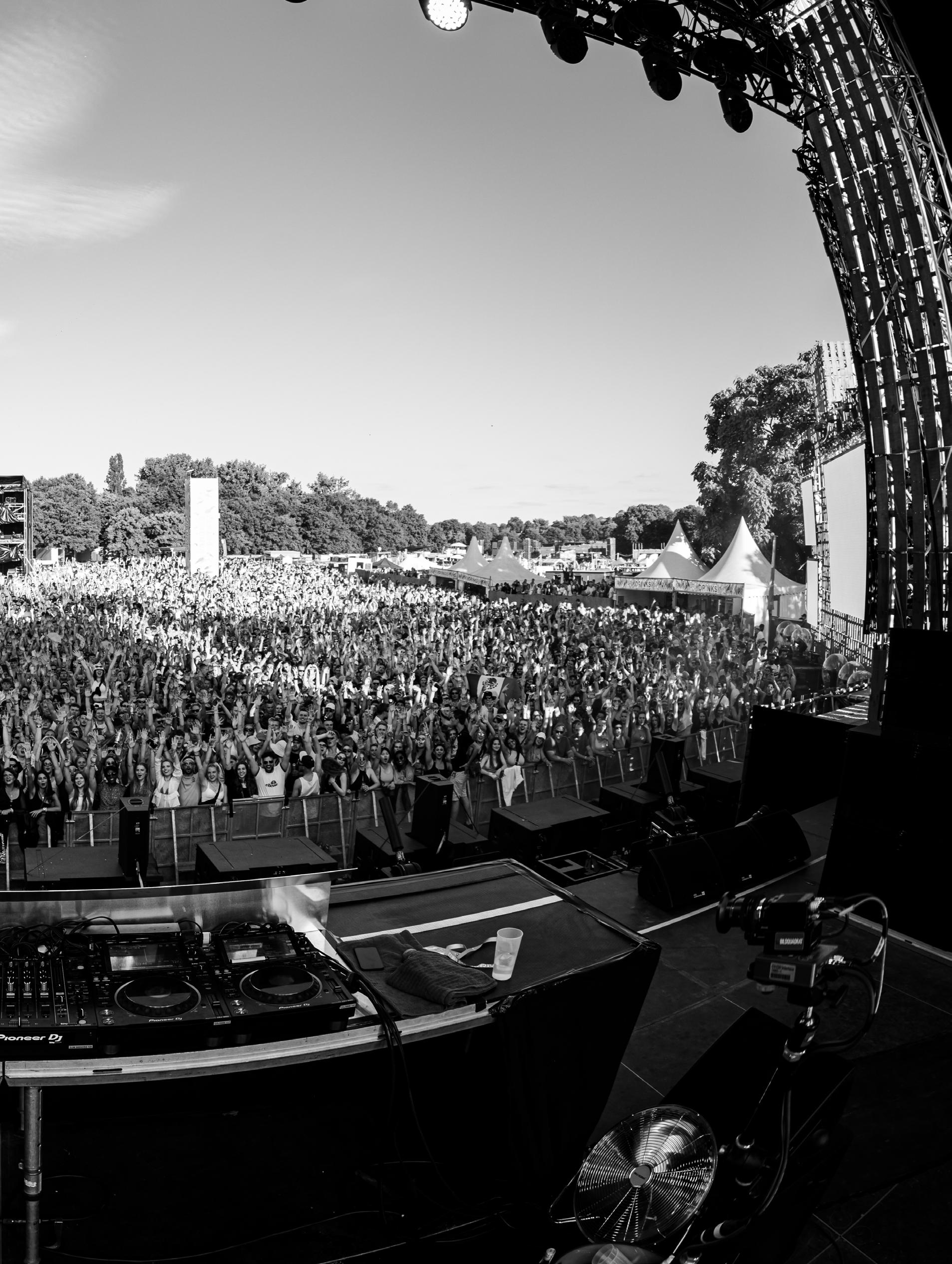
ACRAZE : It’s pretty much the same, as far as DJing and mixing go. I really like the [Pioneer CDJ-3000s] now, because you’ve got the touch screen and I like to be able to navigate with them during my sets pretty easily. As for mixer, I use the [Pioneer DJM-900NXS]. I don’t really love the new mixer, but maybe because I’m so used to the DJM-900 at this point. I’d also have to learn how to really be comfortable on the newer mixer, but I’m always on the go and learning stuff live, so it can be quite tricky, even though it is pretty similar. One of the things I’m doing now is going from USBs to SD cards because I’ve probably lost a thousand USBs, at least [laughs]. I
don’t know who has my USBs out there, but they’re somewhere either at a club or a bar… somebody probably has picked one up and later realized they swooped up ACRAZE’s USB [laughs].
DJ LIFE: Any stories about that?
ACRAZE: Yeah, this one’s actually so funny. I was playing the Ritz Ybor in Tampa one time, and this was before “Do It To It” came out. I walked in and had one USB which was in my pocket, I get up on stage, look at my manager, and then realize that the USB is no longer in my pocket – it’s nowhere to be found. I was telling my manager, “I don’t have the USB,” and he was like, “Well, what did you do with it? It was in your pocket… I let you hold it because you wanted to hold it.” So, at this point we go back out
into the crowd, and everybody sees us looking for it with our phones out, and the whole club is wondering what we were doing [laughs]. Meanwhile, I’m supposed to be headlining the show, but everybody now sees me out in the crowd looking for my USB. It got to the point where we had the entire venue looking for the USB with their phones out, flashlights on. I ended up not finding it… it’s a funny story now, though.
DJ LIFE: How’d you do the show?

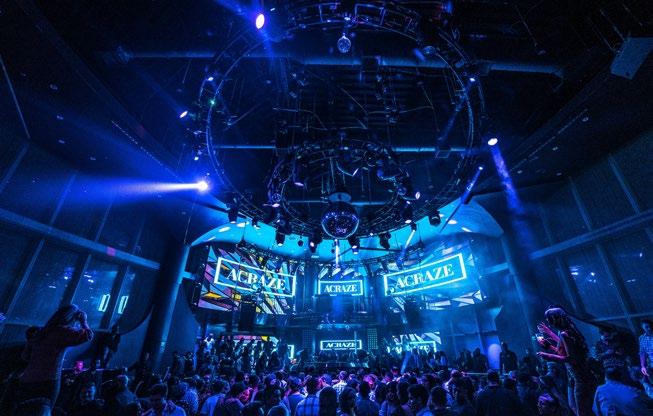

ACRAZE : Some kid in the crowd gave me their USB, so I ended up playing my set off of their music, man!
DJ LIFE: OK, what’s your studio setup?
ACRAZE : Well, the setups are always different… at least now. But even just two years ago or so, I was just producing off my laptop speakers. I didn’t even have
any speakers or [studio monitors] – I couldn’t even afford it. I just didn’t even have the money for it. Now, I’ve got two Yamahas [monitors], a [Focusrite] Scarlett interface, a mic, some analog synths –but even now, I hardly ever really get to use those. I use the speakers now, especially to really test low end on certain songs, but I still like to use my laptop because I feel more comfortable using just that. When I go to studio sessions, it is what it is, and I’m starting to get more used to those now. I remember when “Do It To It” first came out, I was getting put into these sessions and I was actually so scared, man. It was because I didn’t really know what to expect or what I should be doing. It was like everybody was there for me and I had to lead the room somehow. So, I would try all different things out or they would just be waiting for me to pull out a demo that they’d actually like. Sometimes it’s just really stressful so, all throughout this whole time it’s been a process.
DJ LIFE: How has your process evolved?
ACRAZE: I work with my friend Nick [Henriques] a lot now, too, so we get to bounce ideas to each other back and forth. I’m actually posting a video breaking down how I made my new song [“The Otherside”], and you’ll see what I’m referring to about going back and forth, working together on the synths and all of that stuff. I really love when I feel comfortable working with someone because I find that’s when a lot of my ideas really come to life. In studio sessions now, people will say, “Oh, this could be cool.” But, I hate the word “could” as an implication during a studio session because if it could be cool – it might actually be cool if you try it this way or that way. That’s why when anybody ever
says “could be” in a studio session, I make sure that we always just try it so we can determine if it is or not.
DJ LIFE: This most-recent single is “The Otherside,” a collab with Paige Cavell. How did this one come together?
ACRAZE : My friend Paul [Harris], who lives in London, is an amazing writer. He sent me the demo, with a bassline and a kick. It was a very simple demo with a vocal on top – there were only three elements to the song. Right after I heard the demo, I said, “This song’s amazing – can you send me the stems?” So, honestly, we got a cabin in the middle of Canada. I brought Nick with me, and we finished the song together in one night.
DJ LIFE: What drew you to that song?

ACRAZE: This song really spoke to me from the start because the whole story behind the song is about overcoming adversity, becoming yourself, and it’s just about self-love, selfidentity and making it to the other side. Whether that’s because you’re super-depressed, you’re on the other side now and you’re happy; if there’s darkness in your life now, you see light. I remember when I was making dubstep stuff, I honestly felt like I wasn’t myself. When I put out “Do It To It,” I started to finally feel like myself, and I started feeling truly happy with myself and making music. I feel so comfortable in my own skin – I feel like me now. I don’t have to pretend to be somebody that I wasn’t just to try to make people happy, now I’m making music solely for myself. And that’s what “The Otherside” represents to me.
DJ LIFE: After “Do It To It” and all the attention is gained, how did you get re-focused creatively on the music and not get too caught up with the industry
pressures?
ACRAZE : Yeah, I’ll be honest… anybody put in the situation that I was would be scrambled. It’s hard because that pressure is just really intense, man. After the song came out, I would go on interviews and everybody would ask me: “So, what’s next? What’s next? What’s next?” – and it was just really overwhelming. At the end of the day, I would just go back to making music in the studio and try to not think about all of that or “Do It To It.” I’d say, “Let’s just go in and make something dope. If it’s not dope or it’s not ‘Do It To It,’ that’s OK!” At the end of the day, you would drive yourself insane.
DJ LIFE: For a young artist, that’s gotta be tough…
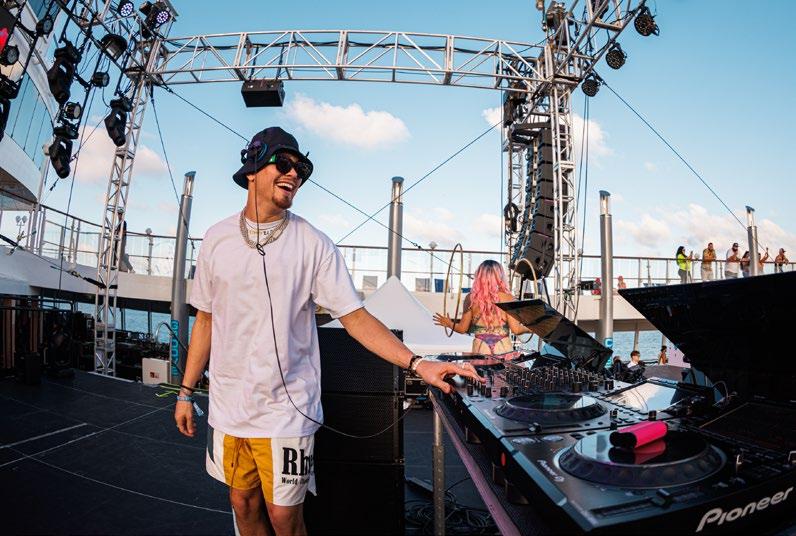
ACRAZE: The main focus as an artist should be: Do not lose your mind… do not lose your fuckin’ mind! Because it’s so easy to when fame and fortune start to come into play. Some people start to become depressed because they aren’t able to do what they did before. You really just have to focus on the music and go in with the intention being why did you start in the first place? I always go back to day one and ask myself: What was the reason you fell in love with music? “Do It To It” is gone, that’s it. Now I’m looking for the new wave. If I notice something I’ve made is really working in my sets, then I might try to get into the studio and make more like that, but even better. Like I said, making music is all about trial and error.
DJ LIFE: Have you played “The Otherside” out so far? What’s the audience response been like?
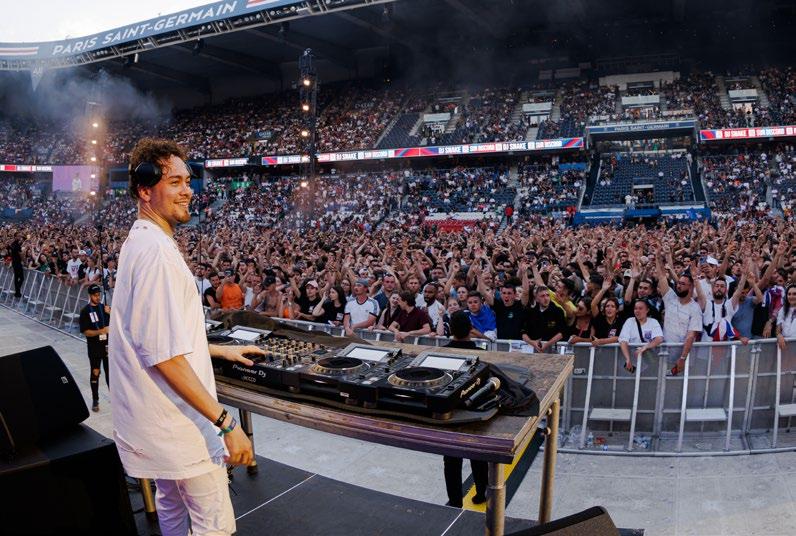
ACRAZE: Yeah! I’ve played it in my DJ sets a few times. It’s definitely a mainstream/commercial type of song. But for my DJ sets, I’ve made it to where


it seems more clubby and it fits my sets. Live, the version that you’ll hear me play isn’t really too far off from the extended version – it’s good! The response has been awesome, and I feel like the energy is perfect. To me, it couldn’t have gone any better. The last time I played it where I got a crazy reaction was Ultra Music Festival in Australia. The crowd was going nuts and there were pyro and fireworks going off – it was a moment. I remember looking back at my photographer and thinking, “Man, this is gonna be a great song.” You can really hear the emotion behind it, which is something I really love about this record.
DJ LIFE: Are there any places you’ve yet to play that you want to?
ACRAZE: [laughs] I think the only places I haven’t played are Russia and Africa. No, I’m kidding, but I’m serious – it really feels
that way.
DJ LIFE: Looking back at your experience in the limelight so far, have you seen anything really surprising from fans? Any stories?
ACRAZE: So, not so much a story, but something that’s just funny to me is seeing people using “Do It To It” as their walk-out song for their wedding. I just think about it, and if I were to do my own wedding, right, I’m not walking out to “Do It To It” – I’m just not doin’ it [laughs]. But it’s crazy, because on TikTok that was all I saw… people using it at their weddings, people doing choreography, the whole thing. It’s wild to me to think that people like the song so much that they’re playing it at their wedding on the day they marry the love of their life!
DJ LIFE: Do you have any pre-show rituals or routines?
ACRAZE: Ah, pre-show rituals… do a shot, let’s get a little rowdy! It’s very easy.
There’s rarely a time where I like it to be quiet or to pray or something like that. I honestly don’t really do that before a show.
DJ LIFE: Did you start out as a DJ or a producer?
ACRAZE: I was a DJ first. I’d say it was about 11 months into DJing and I finally got my first headline show at a nightclub.
DJ LIFE: How did that happen for you?
ACRAZE: I ended up going to this club, and a guy I know ended up buying the club, which actually turns out to be a club I go to now called Celine – one of the biggest venues in the Orlando area. So, before it was Celine, it was called Vain, and this guy Freddie bought the venue, and he was looking to do EDM nights. Somebody referred me to him, telling him, “You need to have this guy DJ.” I ended up being part of the first show, which was on a Thursday, and I had all of my friends there – it was dope, but it wasn’t a headline spot. After that, he asked me to come back on a Sunday to do a headline show, which ended up being close to my birthday, so I wanted to celebrate my birthday. I get to the show on Sunday, and nobody is there.
DJ LIFE: Yikes…
ACRAZE: Now, a lot of my friends didn’t show up or couldn’t come out, but literally nobody is there. I’m talking about me playing for the bartenders. When it got to 12:30 a.m., the venue decided to just shut the club down because nobody had even walked through the door – not a single person. Mind you, it was raining, it was a shitty day outside, and I’m not gonna blame it on the rain. But before I left, one of the bouncers, who knew I was really, really upset about it, said to me: “If you want people to come to
your shows, you’ve gotta be making music… that’s how you sell tickets.” That’s actually when I stopped DJing [for a while]. I didn’t touch a DJ board for another two years. From that point on, I sat in my room, and I learned how to produce music. That was the point where I had a job, and I went back to landscaping and started producing. It wasn’t until I got that support from Skrillex that I decided to quit my day job. I’ve been trying to find that bouncer ever since, but I just can’t find him [laughs].
DJ LIFE: Before we wrap, I know you mentioned wanting to work with Lady Gaga earlier, but are there any other dream collaborators that you have – either DJ or non-DJ?
ACRAZE : I mean, in the DJ world, sometimes it’s a sticky situation, so I can’t really say that there are many others that I’m looking to work with right now. There’s one DJ who I’ve been working on something with, Noizu. I actually played back-to-back with Noizu at EDC Las Vegas [this past May]. He’s actually the only other DJ right now that I’m working with. Any of the other stuff that I’ve done with other artists or DJs just hasn’t worked out so far. I’m actually finding a lot of inspiration right now in the Latin world. I really love Latin music because that’s kind of my roots, so I’ve been working with some crazy artists in that space and hopefully something comes out soon.
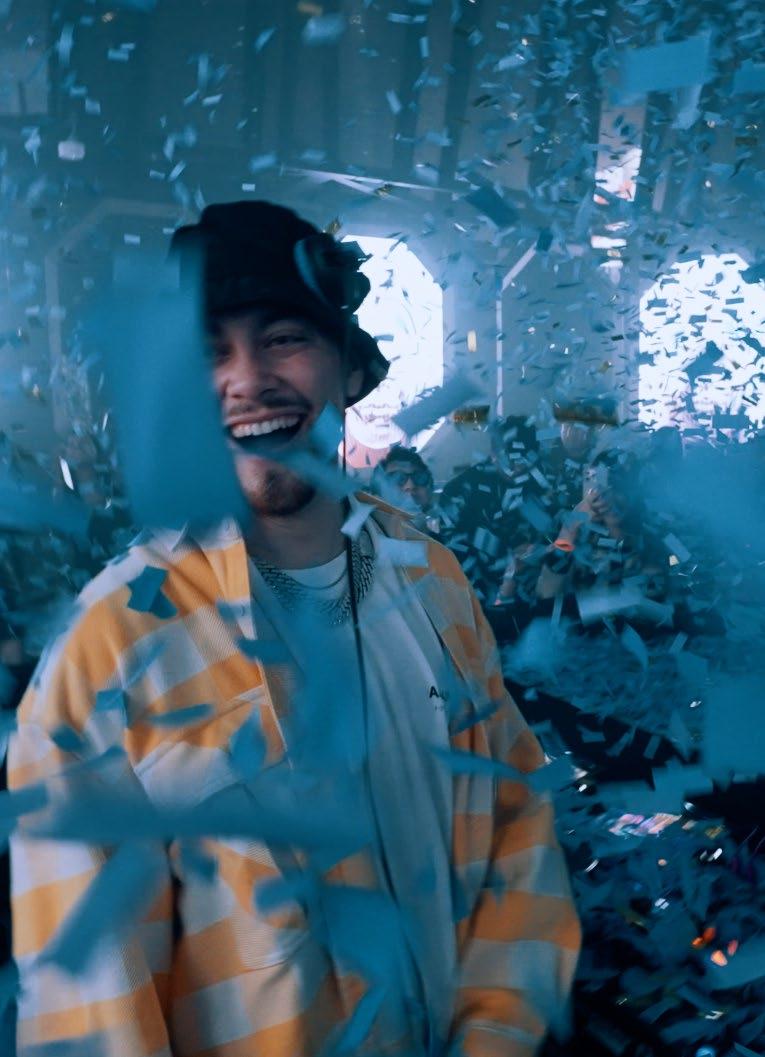
DJ LIFE: Where do you hope to be or where do you see yourself five years down the line?
ACRAZE: Uhm… I really want to win a Grammy, man! I know… and I’m not even really a big award person, but a Grammy is a Grammy. I’d love to win something of that caliber or to just reach that level of success.

Las Vegas – Much of the EDM world – 525,000 fans, according to organizers – descended on the Las Vegas Motor Speedway this past May 19-21 for Electric Daisy Carnival. Produced by Insomniac Events, which celebrated its 30th anniversary, EDC ’23 presented more than 200 performers including some of the industry’s top DJs acts – Above & Beyond, David Guetta, Marshmello, Ti ë sto, Kaskade, Martin Garrix and many more. It all looked like this:



1
4
7
Reach
Mania: Mainstage area goes wild. 2 Entry Point: Fans fill the speedway. 3 Lose Control: An upside-down James Hype. Here With Me: Marshmello gets going. 5 Midnight Rapture: Anabel Englund onstage. 6 All Lit Up: Fans congregate “downtown.” For the Sky: David Guetta on mainstage.

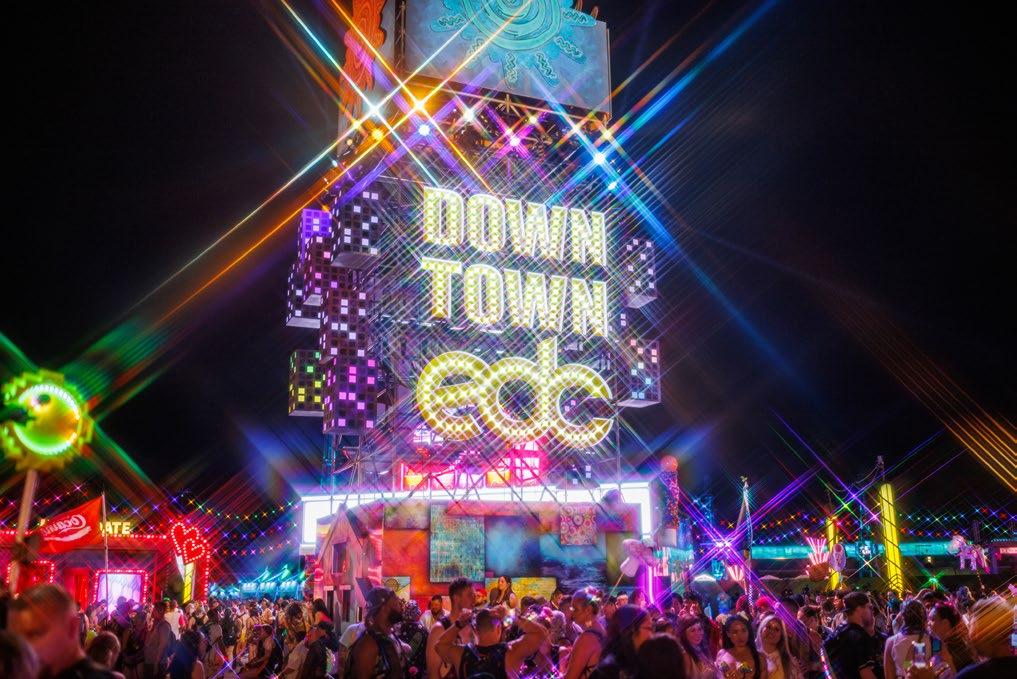




The Overhead View: EDC & Sin City.



Here It Comes: Tië sto preps a big drop.

Carnival Scene: Fans flock to the rides.





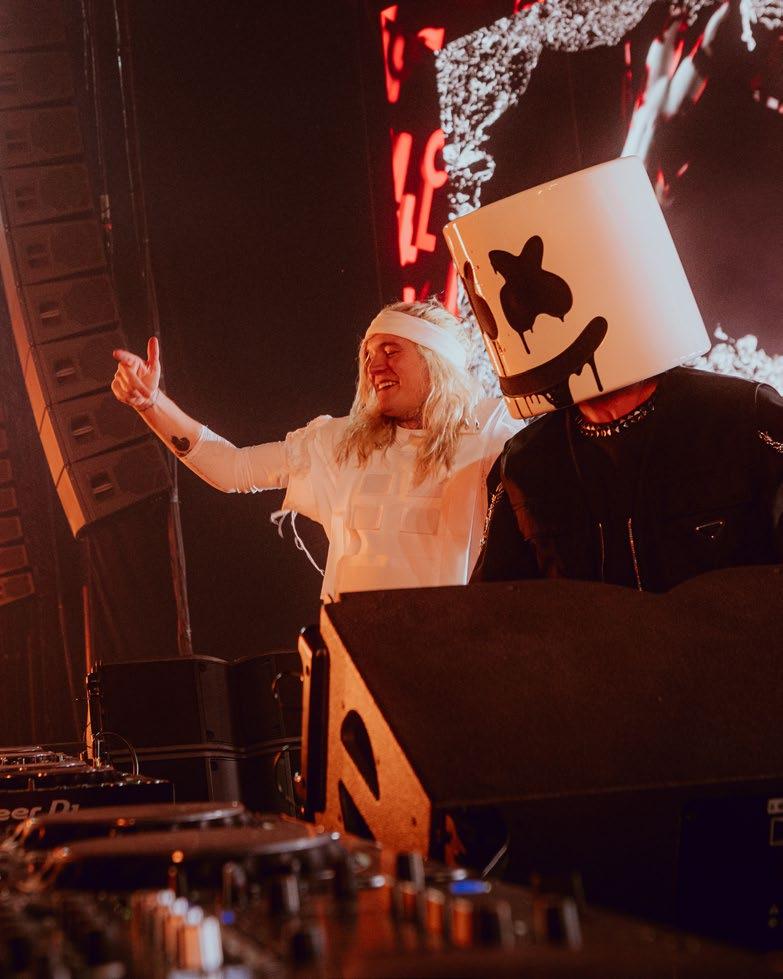
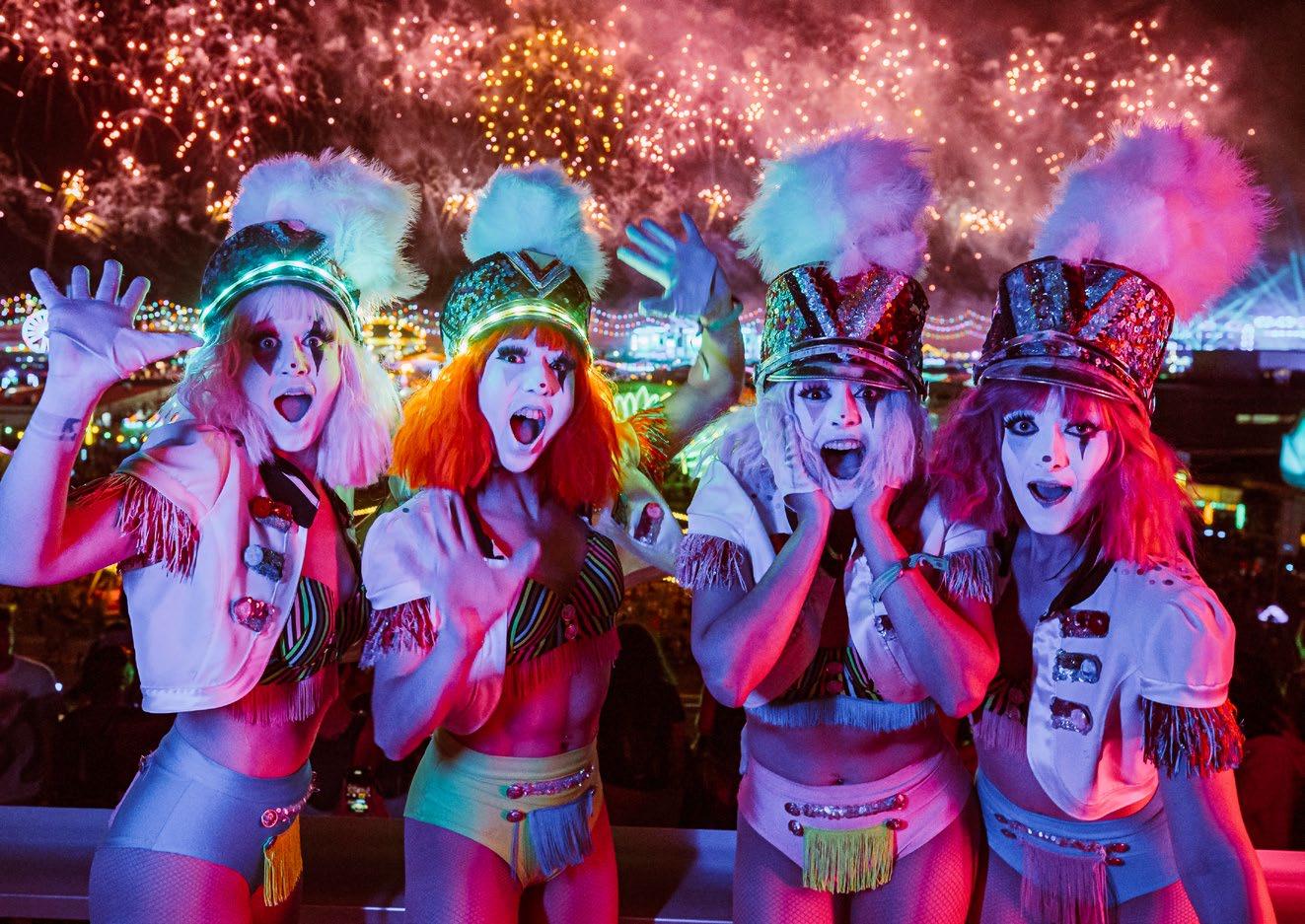
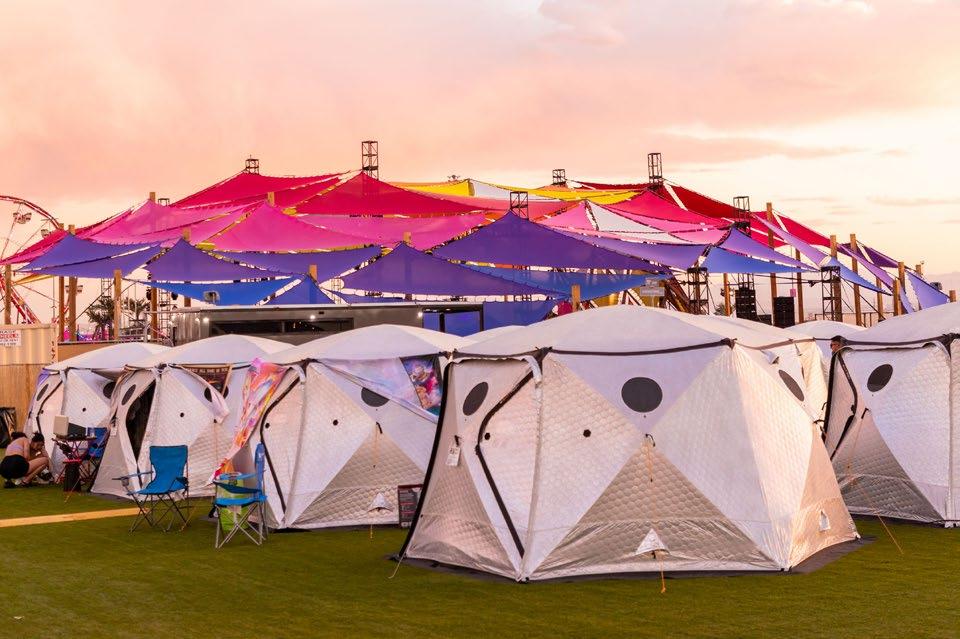
 By Jordan St. Jacques
By Jordan St. Jacques
Greeting DJs... Apologies for no new articles over the last couple issues, but the core business needed my attention. As our company is growing fast (and suffering a few growing pains), I needed to make some changes in the way we operate, including hiring two new people. Like most of you, there’s not enough hours in my day currently to get everything done, and so I had to react accordingly.
One of the methods I’ve put into place fully now at Digitera is extensive use of Artificial Intelligence. So, with all this recent focus on using some of the plethora of new AI tools coming on the market, the braintrust at DJX and I thought it best to give you all the benefits of this research through my upcoming seminars at the show in Atlantic City, N.J., this Aug. 7-10. My own informal perspectives are as follows:
ChatGPT
Let’s begin by briefly reviewing the viral phenomenon known as ChatGPT. It serves as a conversational interface for OpenAI’s GPT-3 large language model, which has recently become available to the public as a free research preview. When presented with text prompts, such as questions or instructions, ChatGPT produces output text in a variety of forms, including prose, poetry, and computer code.
Another OpenAI project, in addition to ChatGPT, has played a significant role in fueling the current surge of consumer interest in generative AI. This particular project takes text prompts and converts them into computer-generated graphics, including images, photographs, drawings, paintings, and more.
Stable Diffusion 2
This is yet another generative AI application that transforms text into images. In contrast to Dall-E 2, the source code of this application, as well as information about the training data and algorithms’ weighting, are openly accessible to the public. Moreover, the application can be downloaded and installed on your personal computer, unlike OpenAI’s projects that can only be accessed through a proprietary cloud portal.
Lumen5
This is a video-creation tool powered by AI, which allows individuals to effortlessly produce educational, marketing, or business-related video content by utilizing a user-friendly drag-and-drop interface.
Soundraw
With the automated music generator, you can effortlessly generate royalty-free AI music by simply choosing the music genre, instruments to be used, the desired mood, and the track’s length. Once the selections have been made, sit back and allow the AI to compose distinct tracks for you.
Looka
This tool facilitates the branding of your business by utilizing AI to produce exclusive and recognizable logos that represent your company’s style and messaging. Even if you lack design skills, this tool makes it effortless to generate personalized marketing material.
Podcastle
This platform provides audio recording and editing capabilities that incorporate AI tools to assist you in producing crisp and polished recordings that sound as though they have been professionally edited. The platform automates tasks such as tidying up distorted sounds and generating transcripts.
Gen-1
This is a cloud-based platform that transforms uploaded videos into new ones by utilizing text prompts to implement desired edits and effects or produce animations from storyboard mock-ups. The creators of Stable Diffusion also developed this tool.
Lalal.ai
This tool employs a neural network system called Phoenix to automate audio source separation. It involves isolating specific components such as vocals, music, or even individual instrumental tracks like drumbeats or basslines from any audio or video content.
Deep
Do you possess historical family photos of distant relatives or ancestors that you would like to see in motion? This innovative tool allows you to animate the faces in family photos, enabling you to witness them smile, blink, and laugh, as if you had captured a video of them from back in the day.
Murf
This text-to-speech engine enables the creation of natural-sounding synthetic vocal recordings in 15 different lan-
guages from a variety of over 100 voices and dialects. The resulting output can be effortlessly integrated into automated marketing or video content, streamlining the process of generating narration and voiceovers.

This tool is specifically developed to translate convoluted and perplexing “legalese” into simple language that can be comprehended by everyone. It is beneficial for both non-experts who desire to ensure they grasp legal documents and for legal professionals to ensure that their contracts and documents are composed in a way that is understandable to everyone.
This AI tool permits the retouching of images by eliminating unwanted objects, flaws, or even people, employing a method called “inpainting” to assist in creating the ideal image.
This tool can be integrated with popular video conferencing platforms such as Zoom, Teams, or Webex, streamlining the process of note-taking and generating transcriptions. It further examines conversations to offer insights into the dynamics and decision-making taking place during your meetings.
Krisp
This is another application for conference calling that utilizes algorithms to eliminate background noise, echoes, and other distractions in real-time. This ensures that you always appear clear and professional during your calls.
Call this collection of tools a starting point, and I hope to see you when we discuss all this and more in-person at DJX, Aug. 7-10, at the Hard Rock Hotel & Casino in Atlantic City, N.J.
Jordan St. Jacques is the President/Lead Digital Marketer at Digitera.Interactive in Ottawa, Ont., Canada.
Bali, Indonesia – Given their different backgrounds, Katya Fadeeva and Ben Locke might make a somewhat odd professional couple, but the Russian/Brit combo have been on quite a hitting streak since their 2020 formation.
As EchoStorms, the multi-instrumentalist/DJ/production team broke out in 2021 with “Tidal Wave,” a shimmering, urgent, and trancey tune that benefitted from Chapter & Verse’s propulsive, techy remix. Successful follow-ups included 2021’s roaring earworm “Delirious” (a collab with R3WIRE), 2022’s frenetic, piano-house rouser “Move On,” and 2023’s cheeky banger “Hallucination.”
During that time, the duo launched its own label, Galactica, gained support from the globe’s top jocks (from David Guetta to James Hype), hit the Top-10 charts on a variety of platforms (U.K. club, iTunes, Beatport, Spotify, etc.), and racked up more than 10 million streams. On the live side, they’re currently in the midst of a summer DJ residency at Canna Bali in Indonesia.
EchoStorms’ sound features a melting pot of styles – house, techno, even smidges of acid, hip-hop, and speed garage – while maintaining a firm hold on melody and a playful affection for vocal effects. A preview of EchoStorms’ work-in-progress debut album revealed a variety of such flavors and more – rubbery basslines, sunny synths, slammers with big hooks. And the group’s latest single, the upbeat “Creator,” sports an urgent hip-house-styled vocal sprinkled over a raw, punchy rhythm. Tightly produced and eminently tuneful, EchoStorms’ latest range of tracks remains as diverse and memorable as anything they’ve done to date.
We recently connected with the Bali-based Katya Fadeeva and Ben Locke to discuss their backgrounds, their artistic process, and, of course, their music.

DJ LIFE: Ben… musically, what were your first influences? Any traditional instruments?
Locke: My grandmother was a music teacher who retired when I was about 3-years old, so I had the amazing advantage of being her only pupil for the coming years. She taught me piano and introduced me to artists such as The Beatles and Elton John. Shortly after this, I got into more electronic artists as well, such as The Prodigy, The Chemical Brothers and Basement Jaxx, to name a few.
DJ LIFE: How did you make the transition to creating music in the studio?
Locke: In my teens, I started hanging out at the local studio and eventually working as an assistant in exchange for downtime, which I used to record an album that would eventually be signed to a sub of Universal. After a few well-received singles, which were played on BBC and two years of solid touring –including some pretty tasty festival slots – the band [Visitors] in which I sang and played guitar and keys and the label parted company. That’s when I really got into pure producing. I was given the opportunity to work on a project with a well-known indie rock band [White Lies], which was happening at an amazing studio in Belgium. Subsequently I worked
on numerous other projects there and basically never left until I was given the chance to work alongside Timbaland out in the U.S. three years later.
DJ LIFE: Right, you’ve worked with a lot of urban/hip-hop acts – what brought you into DJing and EchoStorms, this EDM project?
Locke: I actually started DJing while I was in the band. One of my first gigs as a DJ was at a festival where the band was playing, and they asked us once we were already at the festival if we fancied playing the dance stage. In hindsight, one of the artists that had been booked probably pulled out last minute and they were just desperate to fill the slot. We said yes, unaware of the fact that we would be playing to a tent full of thousands of festival-goers, some of whom had been on it already for two days and counting!
During the period when I was living at the studio in Belgium, my passion for electronic music really flourished as a contrast to the work I was doing with the bands. I started doing more and more DJing, starting locally and building up to shows which included Ibiza Rocks and a residency at one of the biggest nightclubs in Poland [Enklawa]. Being the only house DJ in a circle of hip-hop producers proved very beneficial during my time in America and I ended up playing some really cool shows over there, including P Diddy’s Grammy event!
DJ LIFE: Katya, can you tell me about playing raves in Russia? What kind of music were you DJing at those events?
Katya Fadeeva: My musical taste is very eclectic and what I played really represented that. I like to take people on a musical journey – sometimes I’d start at around 100 BPM and end up at over 150. I felt myself at one with the people and let my senses guide where we were going. At the start in EchoStorms, it was quite strange for me to stay within such narrow parameters when it came to style and tempo, when previously I’d been used to having a totally free reign. But, as some of you might have noticed, our recent releases have been getting increasingly higher in BPM and more varied in production style, so little by little we’re getting there [laughs].

DJ LIFE: How do you two approach DJing together?
Fadeeva: We generally have a pretty clear idea of the journey we are going to be taking when we’re playing shows, as nowadays we’re generally playing only our own productions. Of course, if necessary, we go a little off script, but generally we know what sort of crowds we are going to be getting by doing a little research of the venues and plan a set to suit.
DJ LIFE: In the DJ booth, what gear do you use and why?
Fadeeva: We use Pioneer DJ CDJ-3000s as the pitchshifting is so good and we often nudge tracks up or down a semitone to be able to mix in key with the adjacent track. Mixer-wise, we are very torn between the Pioneer DJM900NX2 and DJM-V10 and have used them both in live situations. They both have features which we really love, and in an ideal situation, we would make a hybrid of the two – the Send Effects section of the V10, which is not there on the DJM900NX2, is amazing as it makes it possible to use reverb or delay independently from the filter, and Beat FX, which gives much more flexibility and options for increased creativity. However, we much prefer the filter section on the DJM-900NX2, as it allows you to low-pass on one channel and high-pass on another, whereas on the V10 you can only low-pass or high-pass on all channels, as you have to select which type of filter you want from a macro button, not from each individual filter dial.
DJ LIFE: Do you have three tracks – though, not your own – that are always available to play in your DJ box?

Fadeeva: The first track has been a staple in our sets since 2021 and we’ve actually done our own edit, so it fits perfectly. The track is “String Theory” by Absolute, an insanely talented producer from the U.K. This track never fails to go off and has a really iconic and unique string line.
Locke: Also, “Sandstorm” by Darude – we play this in our shows as a mash-up with our track “Delirious” and it always works a treat!
Fadeeva: The third track is “Every Step” by D.O.D., another super-talented U.K. producer. We fell in love with this track from the moment we first heard it on New Music Friday and have been playing it ever since. It’s such a lovely, feel-good record.
DJ LIFE: Which DJs do you admire?
Fadeeva: We admire different DJs for different reasons. Obviously, we have a lot of respect for DJs like David Guetta, Carl Cox, Tiësto, and Norman Cook for being able to stay at the top of the game for 25-plus years. That’s definitely something which we aspire to do ourselves.
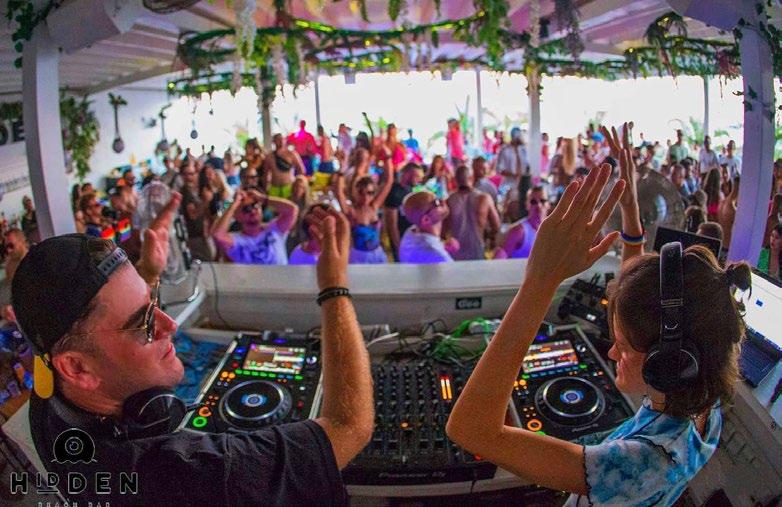
Locke: We also admire the DJs who managed to turn the Coronavirus pandemic, which was a very dark and negative time for the world, into something positive. It was amazing to watch all these communities build online around DJs like James Hype and the whole Stereohype community. We’ve been loosely involved with those guys over the last couple of years and they call their community the “Hypefam” – and it really is just that, a big family. So big respect to those guys – without all the fantastic livestreaming they did during that period and continue to do now there would have been a lot more lonely people in the world. Music should be something which unites people and brings us together, and they did just that.
DJ LIFE: I watched EchoStorm’s performance on the Fundraiser Stream for Ukraine in 2022 and, aside from the very compelling musical program, I was moved by the fact that a Russian was onstage playing with such deep purpose. Considering the often-hedonistic culture of electronicdance music, it’s not often that its artists have the opportunity – and take the opportunity – to make a unique and powerful statement like this. Katya, can you explain the emotions that went into playing this gig?
Fadeeva: Playing this fundraiser set was the greatest honor for me. I wish I could do more to help the victims of this ongoing act of terror. I believe that this war is a horrible crime and reincarnation of the worst cruelty. I don’t support the violent actions of Russian government.
Looking back, I can barely remember exactly how we prepared for this set because after the 24th of February [the invasion date] I could not sleep and found myself in deepest sadness and feeling of sorrow. I do remember that in a matter of a few days we produced most of the set from scratch. The music we played has a strong message and relevance to the ongoing situation. Back then, I never imagined that it would still not be over today. I would do anything to contribute towards peace and the safety of those who are suffering right now.
DJ LIFE: Getting back to the studio… on your original productions, you certainly like to play with effects on the vocals. Where does that come from? What effects unit?
Locke: We’ve always loved manipulating vocals right from the very start when we had our makeshift studio in
the U.K. during our unplanned extended stay in the first lockdown. Probably one of the first effect plug-ins we ever started working with together was SoundToys Little Alter Boy. That has played a massive part in our sound so far and can be heard in tracks such as “Move On” and “Do It For Me.” Like all old habits, which die hard, there is a lot more of that to come on the tracks which we are preparing for the album.
Another vocal plug-in which we use a lot is Infected Mushroom’s Manipulator. We’ve often lost ourselves for hours playing around with vocals using that. Another one we’ve been using a lot is iZotope VocalSynth – it’s like a vocoder on steroids!
We often add a good dollop of ’80s chorus – Studio D, Juno, etc. – for good measure. Then, it all gets run through our vocal chain, which is FabFilter Pro Q3, taking out all the muddy low-end frequencies, into the UAD 1176, LA2A, Massive Passive, and the Maag EQ for a nice bit of air, and then we add a bit of analog warmth with the UAD Studer A800 Tape Machine. For reverbs, we generally tend to use Valhalla or Arts Acoustic Reverb for something that requires a massive cathedral-like reverb and for delays, it’s usually SoundToys EchoBoy, EchoBoy Jr. or Waves H-Delay.
DJ LIFE: From your main studio gear, what’s your DAW? Vital hardware? Other favorite plug-ins?
Fadeeva: We work primarily in Logic. It’s just the best fit for our workflow.
Locke: We couldn’t live without our UAD Apollo. It totally revolutionized vocal recording for us, as it meant we didn’t need to have a physical Neve 1073 or Tube-Tech LA2A anymore, as recording directly into the Apollo with the UAD Unison versions of the previously mentioned hardware achieves an indistinguishable result. We believe in it so much that many of our friends – admittedly, with a small pinch of peer pressure from our side – have cast aside their Scarletts and moved over to the Apollo, and never looked back.
Fadeeva: For plug-ins, we use a lot of the old favorites –Serum, Nexus, Sylenth, Massive, Diva, etc., but the one we really would hate to be without is the Arturia V Collection, and its incredible, all-including browser instrument, Analog Lab. It opens you up to a world where your only limit is your own imagination.
DJ LIFE: What are the next releases from EchoStorms?
Fadeeva: First up is “Do As I Say.” It’s an acid-infused, underground track and I’m on vocals for this one. It’s been in our sets for almost a year now and it always goes off, so we are really stoked to finally releasing it! It’s out on Nervous on July 14.
BUILD YOUR OWN MOBILE APP IN LESS THAN 20 MINUTES NOW WITH AN
PUSH
Ensure your users get your messages by sending notifications
AUDIO
Integrate your playlists and mixes directly into your app
RECORDING FEATURE
Allow Listeners to Send Audio Messages to Your Radio Station
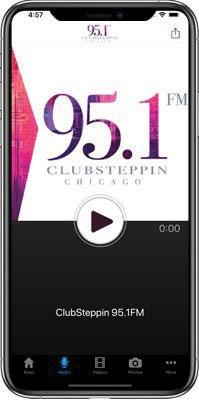

VIDEO
Integrate your YouTube & Vimeo channels directly into the app.
Detailed tracking of the number of downloads and interactions.
Accept song requests and money for those requests in your app.
Allow people to listen to your Radio Station from their watch.
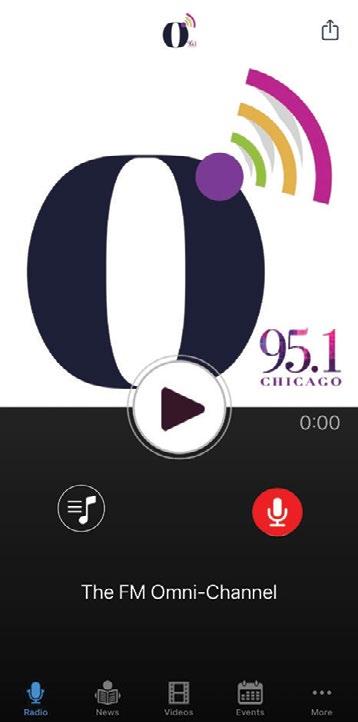


BV Mobile Apps is a leading provider of mobile app creation and hosting with a particular emphasis on apps for radio stations and DJs. With more than 8 years of experience in the industry, we have built a reputation for providing high-quality service and exceptional customer support.





As part of our relationship with DJX, we’re excited to offer ALL attendees and subscribers a FIRST MONTH FREE discount when they create their own mobile app! This will provide DJX attendees and subscribers with an opportunity to build a NO-CODE mobile app at a very affordable price!
Build your app at BVMobileApps.com or download our app to create your own (search “BV Mobile Apps” in the Apple Store or on Google Play).
The promotional code to take advantage of the discount is DJX (not case-sensitive)




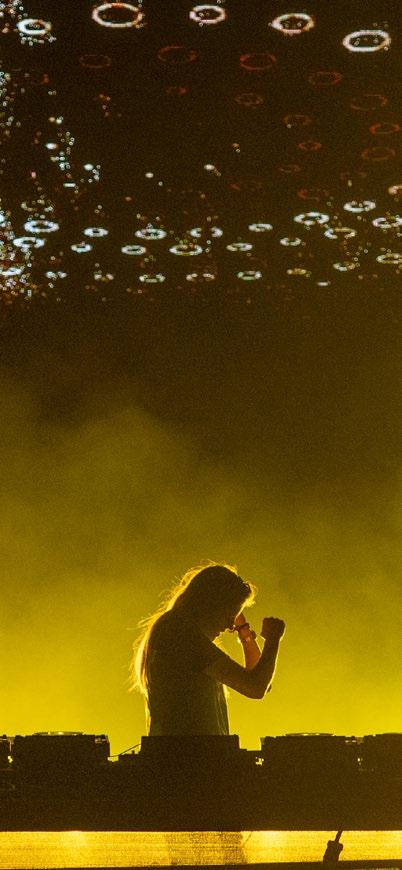
Detroit – Nearly 90,000 fans filled Motown’s Hart Plaza this past May 27-29 for the annual Movement Festival. More than 115 DJ/artists performed on six stages over the Memorial Day weekend. They included a range of diverse acts like Underworld, Three 6 Mafia, Basement Jaxx, Skrillex, Masters At Work, Fisher, Kaskade, and Maceo Plex.
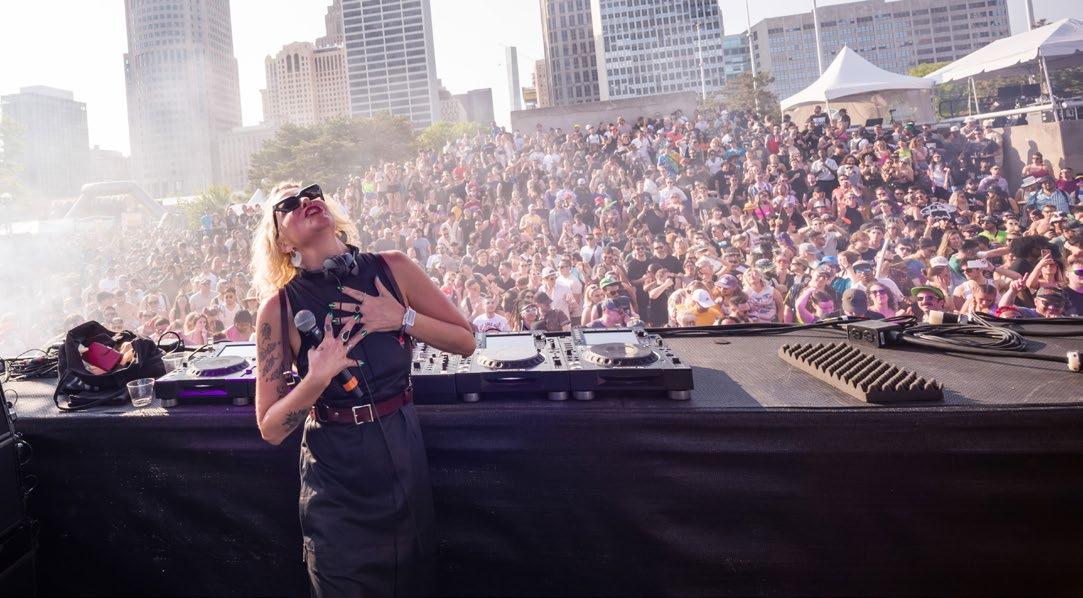


Detroit-based acts performing at Movement included DJ Godfather, Stacey Pullen, Octave One, Stacey “Hotwaxx” Hale, DJ Holographic, Carl Craig, DJ Minx, and several more. It all looked like this:

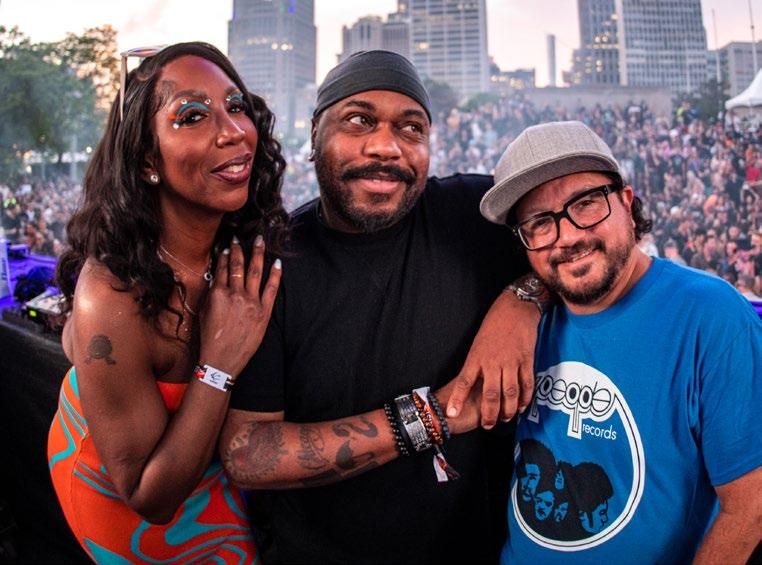
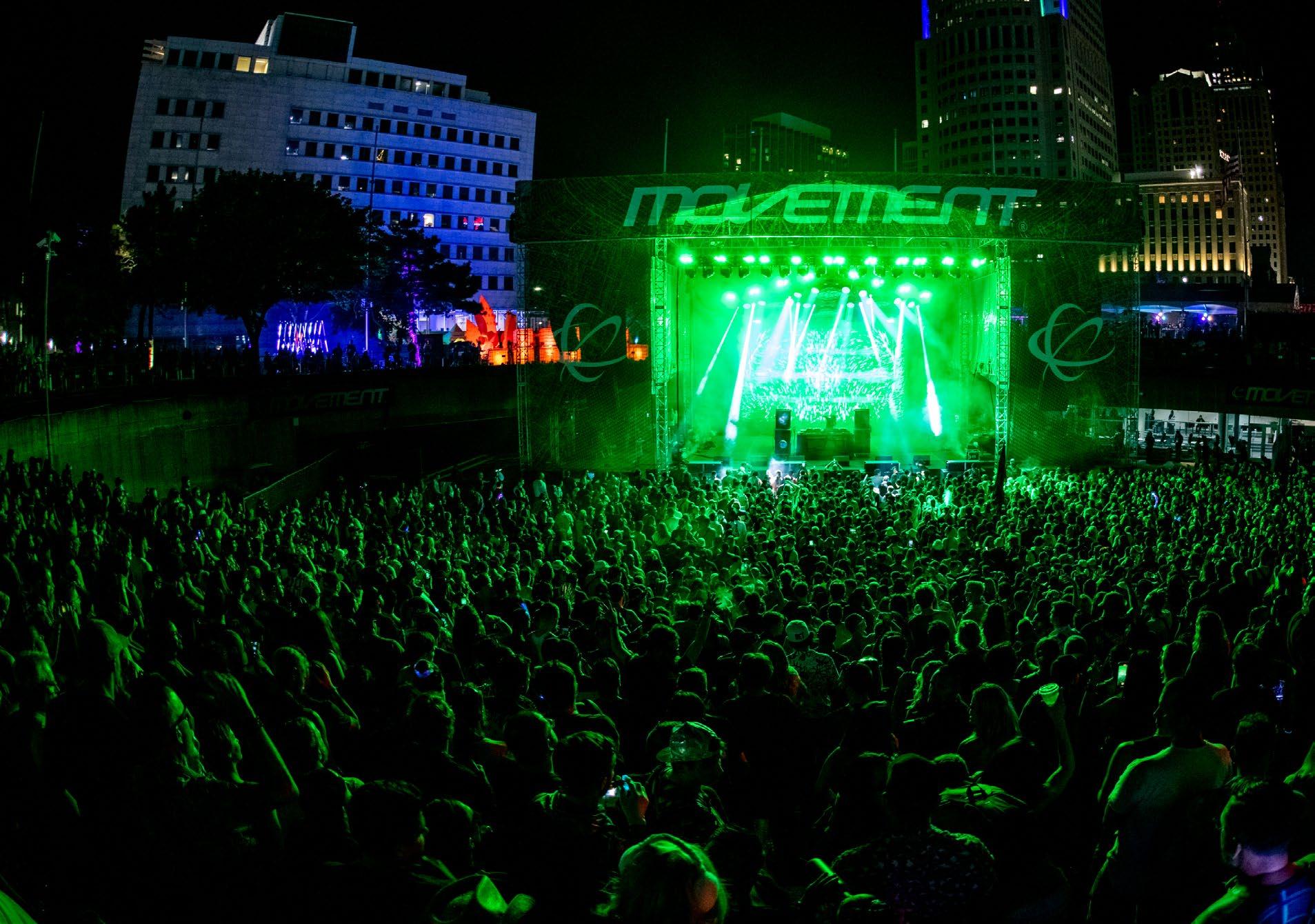



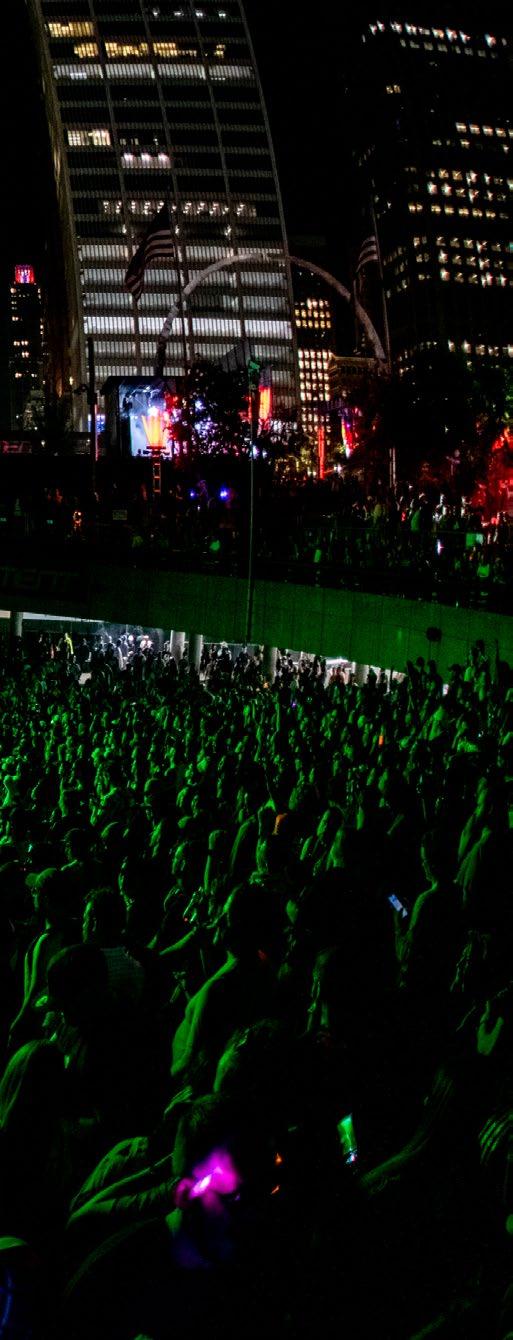




 Groovin’: Ricardo Villalobos on Pyramid Stage. Doug Wojciechowski
Jersey Beats: UNIIQU3 at Waterfront Stage. Sam Siegel
Feeling Funky: Soul Clap’s Eli Goldstein. Christian Najjar
Groovin’: Ricardo Villalobos on Pyramid Stage. Doug Wojciechowski
Jersey Beats: UNIIQU3 at Waterfront Stage. Sam Siegel
Feeling Funky: Soul Clap’s Eli Goldstein. Christian Najjar
Brooklyn, N.Y. – In New York’s after-hours world, Alex Neuhausen and Lilly Wolfson became known for running Secret Loft, an underground party series that kept growing in popularity. Eventually, it led them to opening SILO, Brooklyn’s latest underground club, which debuted this past February. But SILO’s not just the latest cool hipster haunt – it’s different in a variety of ways.
Located in East Williamsburg, not far from the massive Avant Gardner event complex, SILO sits in a military-style Quonset hut and its DJ booth is often placed in the middle of the dancefloor. And, despite its relative limitations in size, SILO doesn’t scrimp on the technical end. It sports a custom Danley Sound Labs system, a variety of powerful scanners, plus a unique projection system that keeps the room engaged with appealing imagery. It’s no black-box venue.
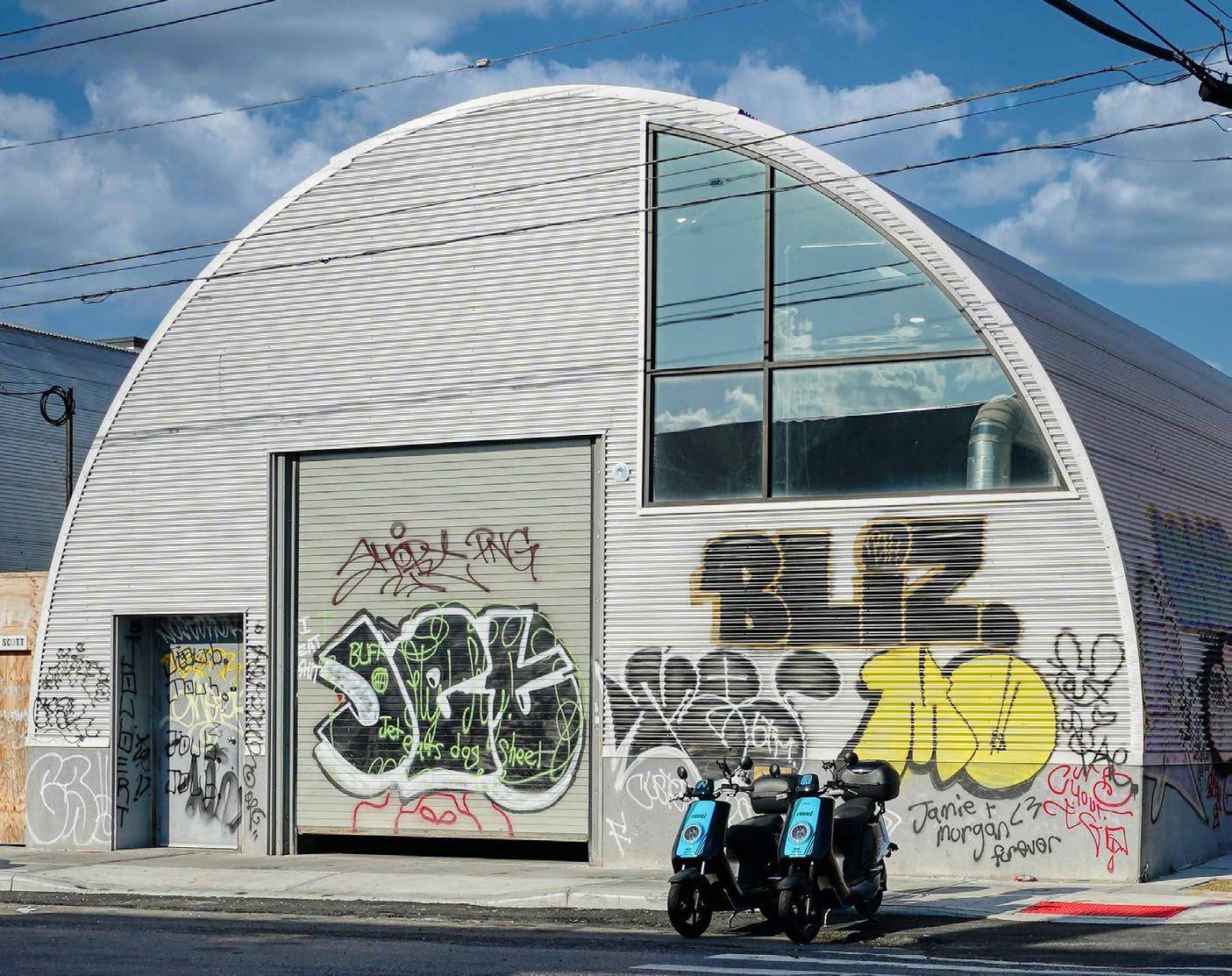
The night DJ LIFE visited, Detroit favorite Stacey Pullen rocked the joint with deep-tech flavors, peaking with WEIRD.’s bewildering slammer “Bagsy.” And when house staff brought Pullen a birthday cake – happy 54, Stacey – clubbers were right there in front of the booth to share in the moment, one of many on a memorable evening.
We recently connected with Wolfson, whose background is in
graphic design and software engineering, and Neuhausen, who holds a PhD in electrical engineering, to discuss their new venture.
DJ LIFE: What was the vision for SILO?

Lilly Wolfson: The building has a distinct semicircular shape, and we wanted it to be a space that felt like its own world, almost like it’s sealed off from the outside…. like a snow globe. We’ve been experimenting with putting the DJ booth in the middle of the floor, which concentrates the energy there and makes the room feel more spherical, and we’re trying out different palettes and immersive imagery to use in our mapped projection system. We’re trying to create a vibe that feels like a waking dream or a shared seance.
Alex Neuhausen: We also want to support the community of local artists and music creators. We’ve started hosting a monthly meetup with Sisters in Sound, a group dedicated to connecting women DJs, and we’re working on putting together a Thursday night series for local DJs. We just organized a custom earplug-fitting pop-up with Crystal Guardian and a bunch of musicians and industry
SILO: Parties in a Quonset hut.people came out for that.
DJ LIFE: What’s the bulk of your DJ and sound systems?
Neuhausen: We have a Danley Sound Labs sound system, which includes two BC218 subwoofers, two SH96HO mains, and two SH46 fills. We have primarily Pioneer DJ gear. We partnered with engineers at Danley Sound Labs USA to model the space and tune the speakers to ensure precise, full-range sound at any point. The Danley BC218 subwoofers are housed in a specially built enclosure designed to reduce bass nulls and prevent sound from dissipating into the back of the room. Handmade sound-absorbing panels were installed across the ceiling.
DJ LIFE: How about lighting and projection?
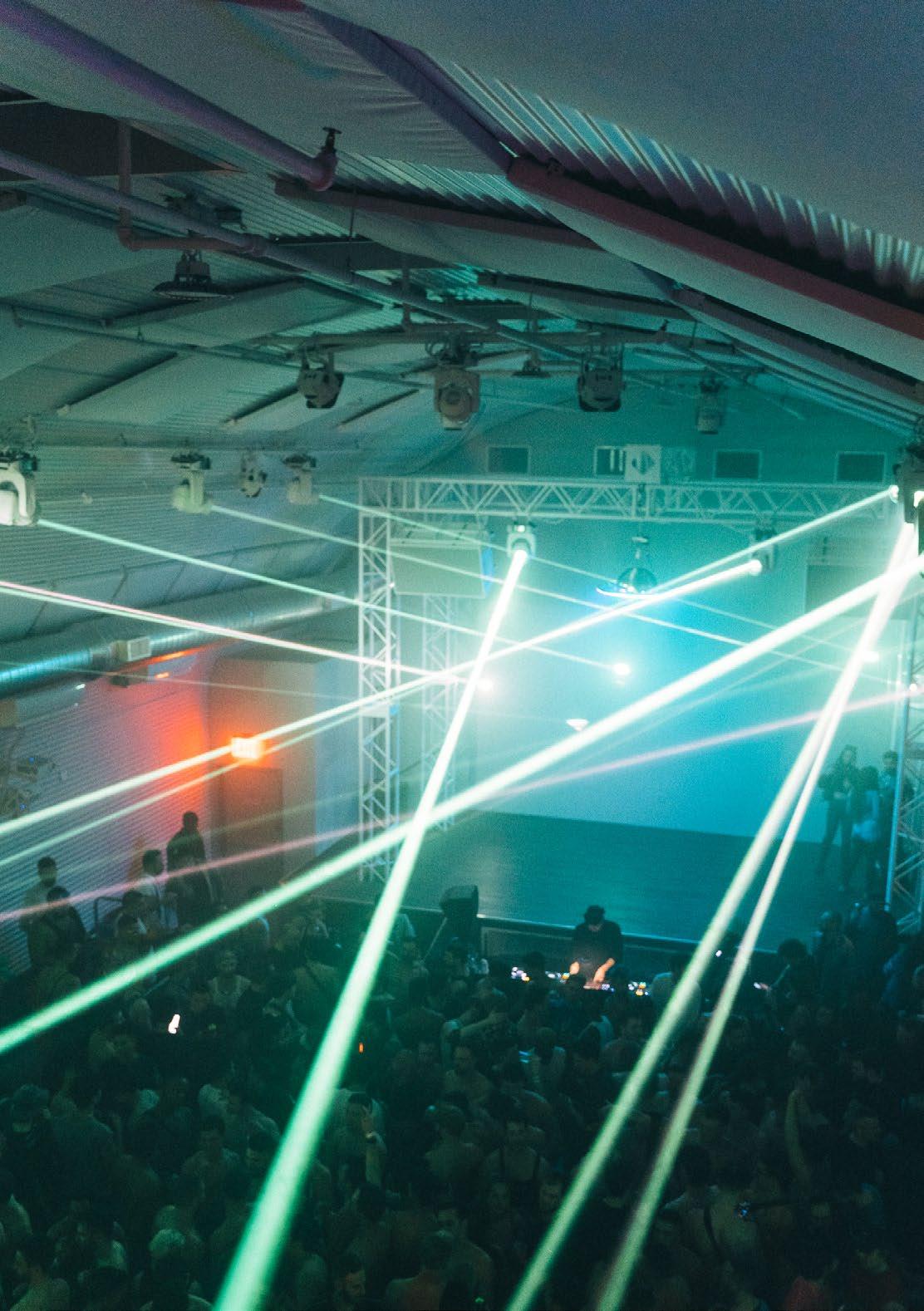


Neuhausen: We have Optoma and NEC Projectors, and Chauvet and ADJ lighting. Our fully custom lighting and projections system features eight high-contrast projectors that have been stitched together to form a seamless 8K image mapped onto the ceiling
 Owners: Alex Neuhausen & Lilly Wolfson.
Royal House: Todd Terry gets busy.
Scanners Aplenty: Late-night action.
Tight Confines: Josh Wink in the mix.
Owners: Alex Neuhausen & Lilly Wolfson.
Royal House: Todd Terry gets busy.
Scanners Aplenty: Late-night action.
Tight Confines: Josh Wink in the mix.
and walls. All of this is controlled from the 16-foot mezzanine, allowing techs to hear and see from the center of the room without obstructing the flow of the dancefloor.
DJ LIFE: Given the physical constraints of the venue, what were the challenges in creating systems that were effective, but not overpowering?
Neuhausen: It’s actually a really tough space to get right for sound. The building is a metal Quonset hut. It’s 5,000 square feet and pretty long, and the floor is concrete slab. So, nearly every surface in there reflects sound waves. To deal with the echo, we installed a bunch of acoustic panels made from sound-absorbing mineral wool, and we put padded vinyl down on the dancefloor to make it easier on dancers’ feet. And there’s foam padding between the tin and building struts, so that there’s no rattle. We’re actually planning to install more acoustic panels soon – we’ve ordered the materials already.
Wolfson: The white tin on the walls is great for projectionmapping. But all those projectors do mean that it’s easy to make the space too bright, so we’ve been working with our VJs and lighting designers to build out a library of images and settings are mood-setting and don’t introduce too much intensity. We’ve started working more with specific background image styles and beam hues, and we try to coordinate effects so that they add the right amount of energy to the room at the right time.
DJ LIFE: Where do you see SILO fitting into the overall New York club scene? What does this venue do that others don’t?
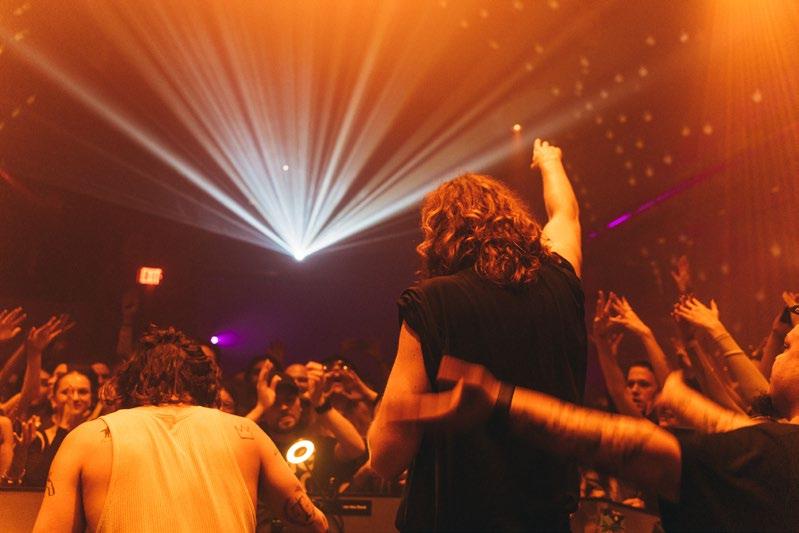
Wolfson: I think our size and layout lend themselves to a certain type of crowd energy. The room is intimate enough for familiarity and closeness, but it’s also big enough to do
high production, so we can save certain lights or visuals for those peak moments and let that ride. Having the DJ in the middle of the dance floor is fun, people can fill out the different levels and parts of the space without being too far from the artist.
DJ LIFE: Venues with smaller, tighter dancefloors often have the most energy…

Wolfson: Yes, so far we’ve found that we get the most energy when we put the DJ in the center of the dancefloor. We also have different levels that kind of break up the height of the place and let people see what’s going on in other parts of the room. So you can dance on the stage, or chill on the raised platforms to either side of the space. We added some platforms and riser-style seating to the back of the main room, too. So there are different spots to move around, you can see the DJ from most parts of the room, and you hopefully don’t feel that you’re lost in a big sea of people.
DJ LIFE: How would you describe SILO’s music policy?
Neuhausen: We’re still new and working on this, and while we know what we like, I wouldn’t call it a policy just yet. We try to put together bills that are musically coherent, but also a bit surprising, and we appreciate artists who mix it up and take risks.
DJ LIFE: Memorable events so far?
Wolfson: One Sunday after a full weekend of events
– I think it was our third weekend open – we got a call from Fred Again’s tour manager asking us if Joy Anonymous could do an impromptu show that night at the venue. So we had something like four hours to organize security, get the staff together, make a flyer and ticket pages, and sort out all the other logistics. The staff really came through, though. It ended up being cool, but definitely also a wild thing to have happen on week number three.
Neuhausen: Circe was a party that we hosted on our opening weekend. The event has a lineup of women DJs and witchy, dark, and deephouse vibes. We covered the DJ booth with LED candles and our in-house VJ Hannah did a lot of cool visuals with cathedral windows around the walls of the space. Around 1:30 a.m., during Tara Brooks’ set, with everyone in a circle around the dancefloor looking at this like DJ altar, it felt hypnotic, like a seance, like you weren’t really in a warehouse in Brooklyn anymore… you were in a dream.
Circe Party: Tara Brooks on the decks. Jumpin’: DJs connecting with fans.


It’s hard for me not to look at a calendar these days and marvel at just how long I’ve been DJing and playing with DJ tech. Let’s just say it’s been long enough now that I think I’ve earned certified old-timer status. And as I look back, I continue to be amazed at just how much has changed about the art form and the gear we use to create it over all these years.
One thing hasn’t changed in all that time: The position of Pioneer DJ in the market. If you’re playing a leading venue, chances are that the house equipment bears the Pioneer DJ logo, and it continues to be the aspirational gear of choice for many a professional DJ –whether you’re performing on a stage, in a DJ booth at a venue, or setting up on a folding table to work your latest wedding gig. The centerpiece of many set-ups remains, of course, the mixer, and Pioneer DJ has recently rolled out a solid upgrade of its 4-channel flagship, called the DJM-A9.
This new mixer succeeds the ultra-successful DJM900NXS2, which itself set a new standard when it debuted in 2016. But the DJMA9 takes the staid notions of an old-school DJ mixer and injects a healthy dose of steroids that elevate things to a new level.
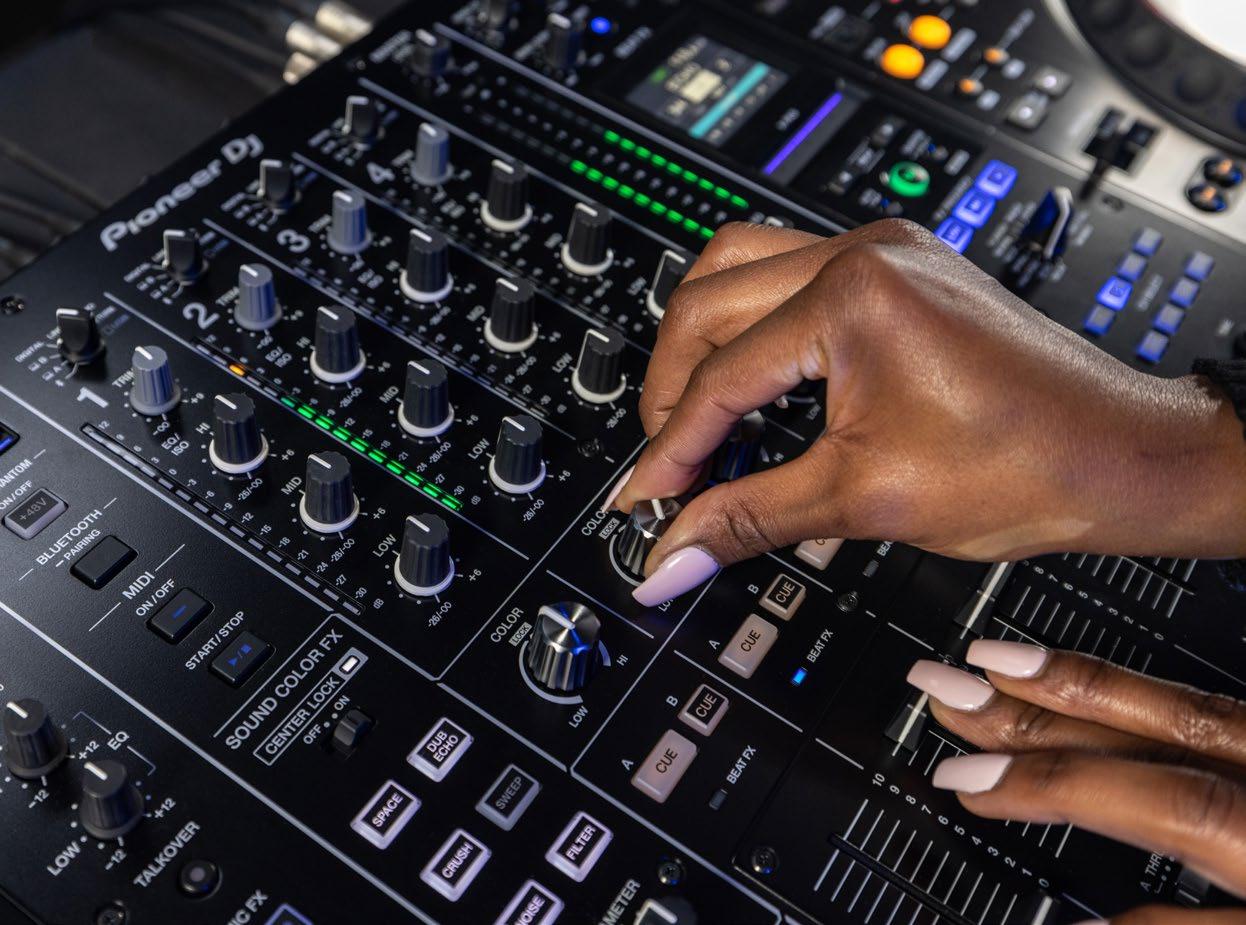
What’s New?
Pioneer DJ seems to lead its talk track about the new mixer with the audio technology that’s gone into it, highlighting the A/D-D/A converters used (from ESS Technology), while also highlighting audio improvements to things like the mic inputs and headphone outputs. Candidly, I’m not sure that these improvements are necessarily noticeable over the DJM-900NXS2 given that mixer’s topdrawer capabilities, but I’ll take them at their word.
I think, for me, the real story here is around the source flexibility of the DJM-A9. For a start, Pioneer DJ put both older style USB Type-B and newer Type-C ports on the unit in a dual configuration, allowing you to have two Mac or Windows computers (running Pioneer DJ’s own rekordbox software, or Serato DJ Pro) connected at the same time, either for flexibility or for DJ-set handoffs.
Add to that new Bluetooth capabilities, which open the door to novel
wireless connections like using a smartphone as a source, and it begins to feel like the DJM-A9 lets you hook up anything you might ever need or want to incorporate in your DJ set — largely because that’s exactly what it offers.
It’s clear the sort of environment that Pioneer DJ designed the DJM-A9 to reside within, given various and sundry other niceties, including such things as dual, individually controlled headphone outputs (again, great for DJ handoffs); EQ adjustments on the booth
output; new effects for those already offered previously for the microphone inputs; and even the ability to use a condenser mic with phantom power. On that last point, I’m not sure I can see delicate condenser mics being used in a DJ booth, but perhaps my old timer status is causing some “use-case myopia” here. There are other applications beyond the booth, of course. (From Pioneer DJ: Phantom power for condenser mics serves two purposes. One, it allows the DJM-A9 to be used in a broadcast or streaming environment, where DJs may prefer using a condenser microphone. Secondly, it gives DJs the option to use the DJM-A9 as a recording interface with a proper studio microphone. This gives DJ/producers the ability to take advantage of the high-quality converters, not just in a live performance, but it in a recording environment as well. This is also why there are dedicated effects just for the microphone.)
Further evidence of the environment it was designed for? The new Stagehand capabilities that are at this writing are still labeled as “coming soon.” It allows a front-of-house team to tap into the mixer in various ways, enabling an audio engineer, for example, to better control the sound. (Given how many DJs seem to live the “dial-itup-to-max” philosophy, this may be a very good thing.)
Of course, as I implied above, it goes without saying that the back panel of the DJM-A9 offers an almost
ridiculous number of connection points, not just for inputs and outputs, but also for effects send and return, the dual mic inputs — one ¼-inch TRS, and one dual XLR/TRS — and for the Pro DJ Link RJ-45 connector.
Pioneer DJ has also bestowed other improvements upon the DJM-A9. These include even more effects controls, but also basic usability improvements like a center-lock position on the Sound Color FX controls, as well as the simple addition of more space around the EQ knobs so your fingers are less likely to bump levels you’re not trying to adjust.
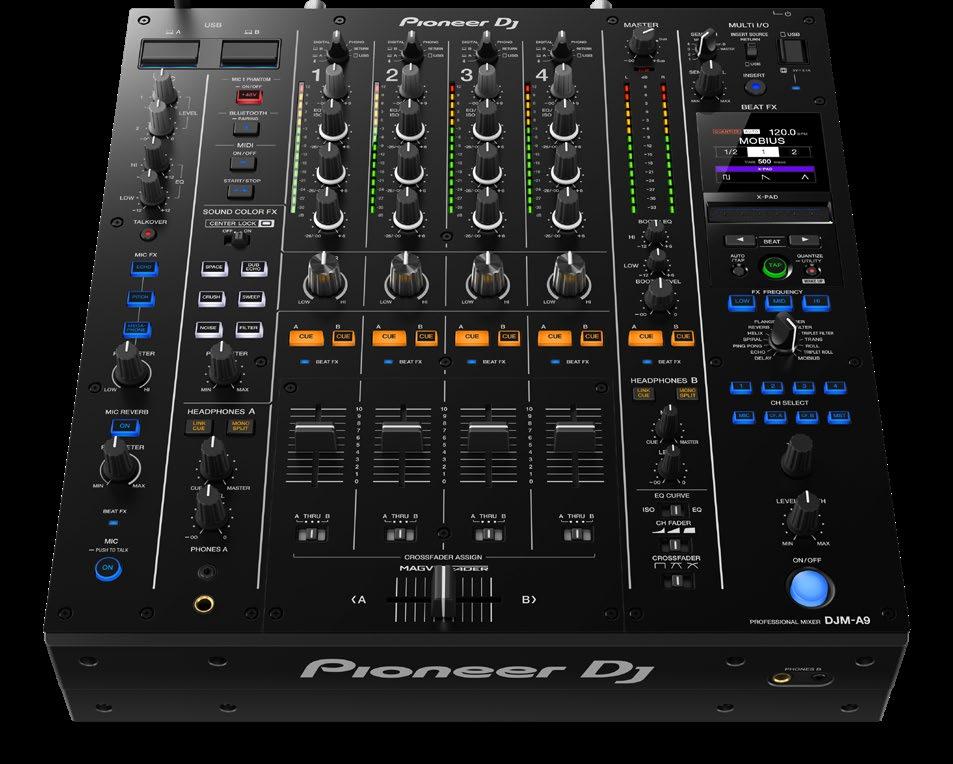
So how is it, hands-on? I’ll start by saying that testing a mixer like the DJM-A9 to its absolute fullest within the limited time typically provided to a reviewer is a near impossibility, but I did what I could, and I can very easily cut right to the chase: It’s extremely difficult to find fault with the DJM-A9. Pioneer DJ has been at this game for a long time, and dare I say, its engineers knows how to
make a mixer targeted to the high end of the market, and they do it well.
Honestly, it seems gratuitous, perhaps even insulting, to try and grade the way that the DJM-A9 feels. All the controls are exceptional, responsive, and solid under the fingers — just as you might expect of any product made by this brand.
One thing worth mentioning is that, while Bluetooth connectivity is a massive plus and something many a DJ will avail themselves of, it does raise the issue of contending with a bit of signal latency — which, while not extreme, is nevertheless present. Depending on how you’re using or controlling the source itself (e.g., your smartphone), that may or may not be a big deal, and certainly Pioneer DJ can’t really circumvent the laws of physics here; it comes with the Bluetooth territory.
In any case, the DJMA9 is clearly a solidly built, great-sounding piece of kit that uses some of the best components available, all packaged in an extremely robust tank-like cabinet. It’s
big — over 18-inches deep, over 16-inches wide, and standing just over 4-inches tall. But part of my sense of its bigness comes from its sheer weight: nearly 23 pounds. That said, the several dozen knobs, buttons, connectors, sliders, and faders that make the top panel look like the inside of a Boeing cockpit, plus almost 40 connectors on the back panel, and all the circuits to make this thing work, aren’t going to add up to something you can pick up with one hand.
Beyond the weight, of course, is the cost: $2,699. But we’ve already established that the DJM-A9 isn’t for amateurs, and it’s probably not even the ideal choice for the majority of mobile DJs (although its features would surely appeal to them all). But for the type of customer that Pioneer DJ is catering to with the new DJM-A9, I dare say that they’ve hit a home run. It’s one of the best mixers I’ve ever laid hands on, and that’s likely to remain true… at least until Pioneer DJ devises its successor in a few more years.
“IT’S ONE OF THE BEST MIXERS I’VE EVER LAID HANDS ON, AND THAT’S LIKELY TO REMAIN TRUE… AT LEAST UNTIL PIONEER DJ DEVISES ITS SUCCESSOR.”
Maybe nothing better illustrates the overlap between music production and DJing than DJ-software companies rolling out their own production software. To wit, we saw Serato Studio 2.0 introduced earlier this year, and it’s a major update to the beat-making platform that was first released in 2019.

By now, New Zealand-based Serato should be a name familiar to most DJs. Serato DJ Pro is one of the very most popular DJ-software options currently on the market and has a devoted following. However, the name Serato may not generate the same recognition among music producers.

That could certainly change with the latest generation of Serato Studio, which hopes to woo both DJs and producers alike with a rich feature set and sample-focused workflow. Interestingly, the Serato story actually started in 1999 with the release of the time-stretching/pitch-shifting plug-in “Pitch ‘n Time.” Will Serato Studio 2.0 more fully ingrain the company in the world of music production?
The centerpiece of Serato Studio 2.0 is real-time stems separation – in other words, the ability to split a song into distinct pseudo-tracks with each containing either vocals, drums, and melodies. With this feature, you can create acappellas or instrumental edits on-the-fly and alter one without affecting the others. This technology has been emerging in various DJ software and hardware platforms in recent years and has unlocked new creative possibilities for DJs.
In the software, stem separation really sounds great. It’s certainly on par with the stem-separation algorithm found in Serato DJ Pro. Of course, an acappella created through stem separation is not going to sound as clean as a true studio acappella, but it can get pretty close under the right circumstances. With the introduction of stems in Serato Studio 2.0, Serato appears to be going after remixers and producers wanting to take their sampling game to the next level. In fact, they call it “the single biggest breakthrough in sampling technology since the digital sampler.”
The rest of the Serato Studio 2.0 workflow is very similar to Version 1.0, which debuted a few years ago. There is the ability to load various drum kits and build a beat using a drum machine-style workflow. When compared with other music-production platforms, a real defining feature of Serato Studio is the ability to load tracks directly from your Serato DJ library. There’s also the ability to layer on some synths and throw effects on the track you’ve created.
Various phrases of a project are split into sections known as “scenes,” and you can chain multiple scenes together to form a track. The software seems to focus more around sampling various sources, as opposed to building entirely new songs from scratch. As a platform to create remixes and edits of preexisting tracks, Serato Studio offers a nice blend of DJ and production software.
In the software, there are nods to DJs everywhere. For instance, there is a central mixer-style section in the middle of the interface – it even has the 3-band EQ that we’re all used to. Having said that, music-production super-users might find more-featured music production platforms to be a better fit – especially if they’re trying to create distribution-ready tracks for a record label.
As a beat-making tool, Serato Studio 2.0 might also appeal to non-DJs who want to be able to quickly put together a beat. DJs who are wanting to get their feet wet with music production might also consider giving Serato Studio 2.0 a try.
There are two flavors of Serato Studio: a free version and a paid version. Importantly, both the free version and the paid version contain real-time stem separation, which I’m very glad to see. The free version is limited in the number of audio tracks, sound packs, drum kits, and instruments users have access to. My recommendation would be to try the free version and see if the software makes sense with your workflow.
If it does, the $9.99-a-month subscription or a one-time $249 price for the paid version might be very compelling.
Thumbs up on Serato Studio 2.0.


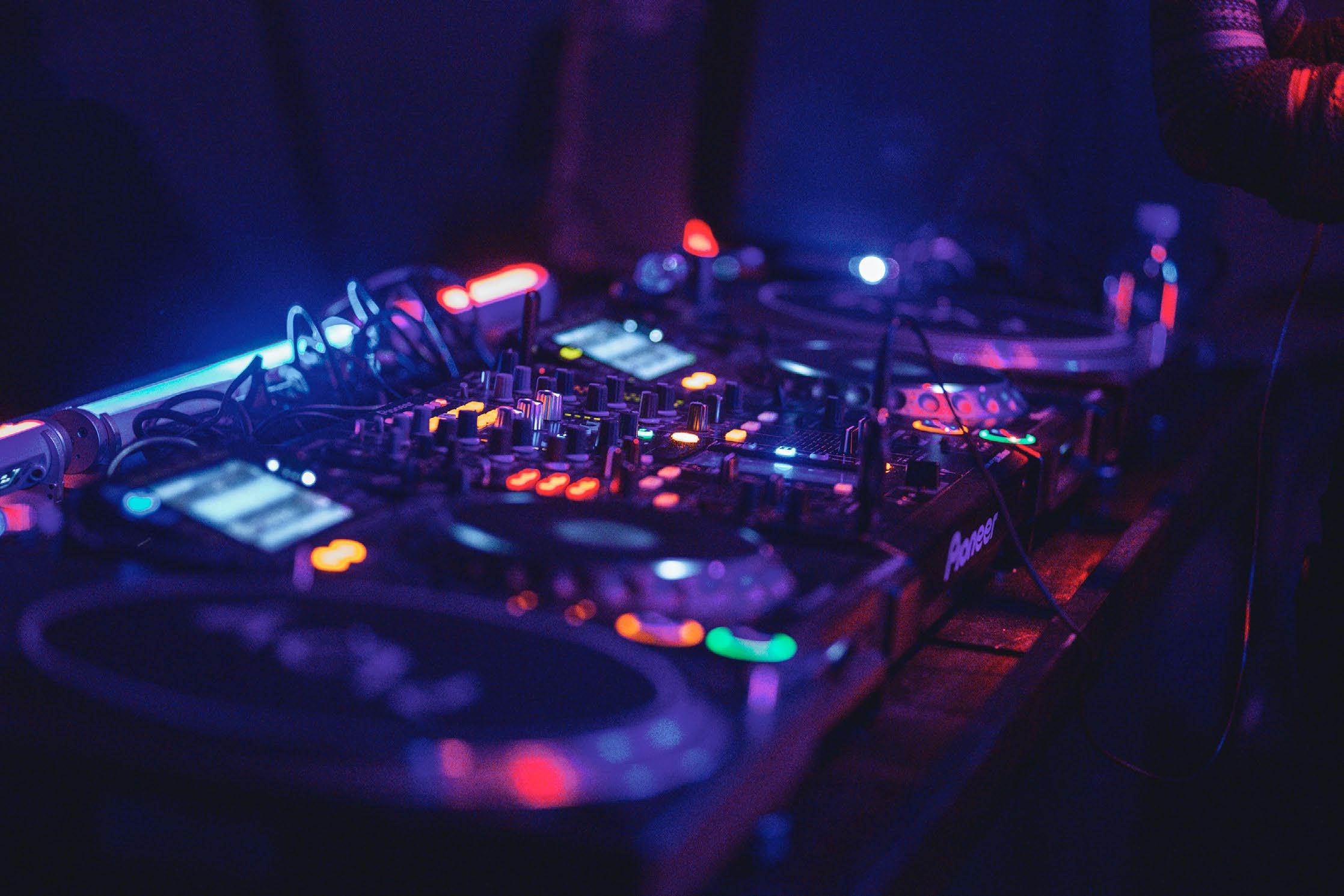


 By Stu Kearns
By Stu Kearns
Hillsborough, N.J. – You might know Xavier J. Powell from his appearances at DJX — he’s spoken at DJ LIFE’s Atlantic City show the last two years about brand-building and sponsorships.
If you’ve missed his seminars, we talked to the owner of Sounds of Jersey and asked him about his journey, his customer service, and how to keep people from scrolling their phones at gigs due to boredom.
DJ LIFE: When did you start DJing?
Xavier Powell: In January 2012. However, I’ve worked in the music business since I was 16 years old. I’m talking about working at record labels, as an artist manager. I’ve done every aspect of the music business and DJing is my last hurrah per se in the industry. I’m having a ball out here. And so I still get to enjoy music without having to deal with the politics of the music business.
DJ LIFE: Tell me about the transition. When did you start realizing you could DJ and make some money?
Powell: Well, what happened was, a young lady saw me on the train heading from New Jersey into New York. And she remembered me when I was a radio personality – I hosted a party. She told me her daughter was getting married and looking for a DJ. I used to be a radio person, like almost the same thing as a DJ, but definitely not the same thing. But, it really intrigued me, so I bought equipment and I started watching DJs, going out listening to them. And not only that, but I’d listen to what music people responded to, what kind of drinks they were drinking… like what made them dance, what made them go on the dancefloor. I looked and just picked apart every aspect of the business part of it, and the psychological. So the transition was actually pretty easy because I’ve always been into music. That’s always been the passion for me.
DJ LIFE: First off, how did you get gigs?
Powell: Well, this is what I started noticing. One common thing about DJs is that as somebody would come up to a DJ booth at an event and say, “You’re a pretty good DJ – can I have your business card?” The DJ will say, “Oh, yeah, here’s my card, give me a call when you’re ready.” I’m not sure if it was just DJs being lazy, or this is what they were taught, or this is what they saw other DJs do so they decided to follow suit. But, to me, from a customer-service aspect, that’s terrible. And I looked at it like, “OK, I can do this much better.” So, somebody comes over to me and says, “Hey, listen, I’m about to have a party and I need a DJ – do you have a business card?” I would go on a hunt like I was a lion attacking a deer. I’d say, “What’s the date? Can you give me your email address?” And follow up from there. I’ve even taken deposits that way.
DJ LIFE: So tell me how are you generating gigs?
Powell: I’m gonna tell you a secret. One of the biggest ways that I generated gigs was going to open houses for
catering companies. These some catering companies in Jersey will own or manage different venues. So, when they have an open house, I will go to the open house and set up lights. So, the people come in there and see the lights and come over after talking to the person about the food and the venue and be like, “Hey, you do lights? Do you DJ, too?”
DJ LIFE: What’s the sort of set-up of your company? Do you sub gigs to other DJs?
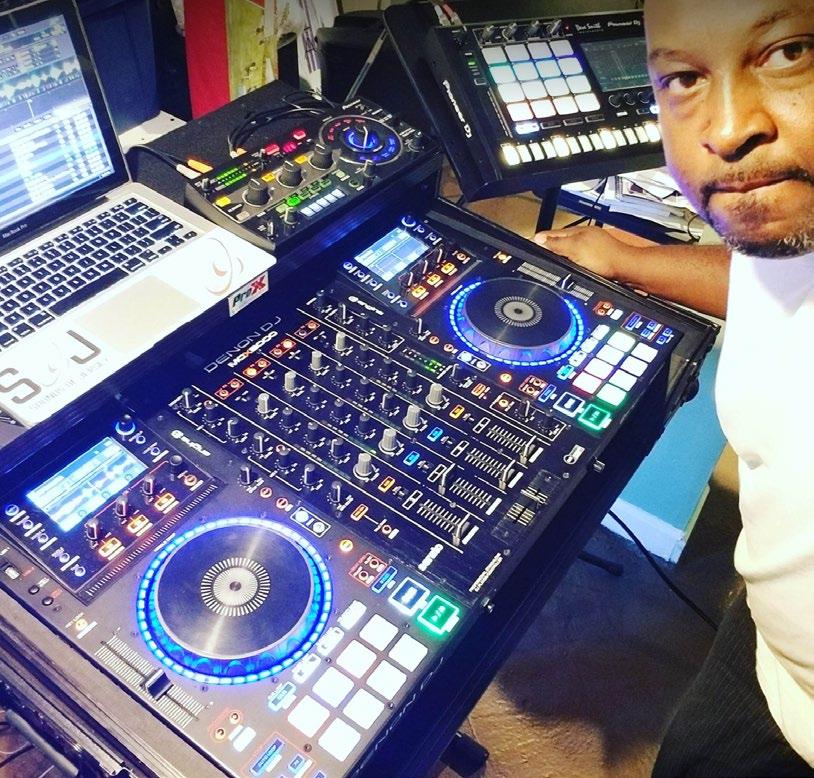
Powell: I do sub out to other DJs. I hire other DJs as well. A lot of times I’ll provide the service, the customer-service part and the DJ shows up with their laptop, and we make sure wires are not showing and the set-up is clean and precise. So, the client gets the best of both worlds — great customer-service to great sound, great-looking lights and everything in the DJ that they want. So, it doesn’t necessarily have to be me, as long as my company makes money. I’m happy for each of the company. Even though it’s my company, you know, the employee always makes less money. I don’t care, as long as the company makes money.
DJ LIFE: You do mostly weddings?
Powell: I do a lot of weddings. My weddings are probably my bread-and-butter because of how I do my weddings. Let me give you an example. I have a customerservice rep that’s in the parking lot that guides the guests for the reception. That’s the first thing they see coming into the parking lot. That’s where the customer experience begins. We tell them where to park, where the door is, etc.
DJ LIFE: What other add-ons do you do?
Powell: We also do how-we-met video. So, I interview the bride and groom separately and together and put together a video of funny stories of how they met.
Powell: I also record their wedding vows and then add it to the music. When the best man does toasts and bridesmaids do their toasts, those are added to the music, and I put everything on a USB or CD or whatever they want – so, they’ll have a keepsake. There’s a lot of things like that. That’s what I do. And that’s what I give and I give it for free — although I’m expensive.



















































You’ve seen it, you’ve heard it, and you’ve probably even been lectured about it. Marketing is an essential part of any business or organization, regardless of size – and this is becoming even more important in 2023.
This is still very true today for DJs everywhere, but many struggle or have difficulty developing a good marketing plan for themselves. Why?
Because some may not see that a great plan will actually help them reach their target audience better, increase their brand awareness, and the most important of all… it will drive sales if you offer entertainment services for events and
One of the most important aspects of good marketing in the DJ industry is having a strong brand identity. This includes having a clear and concise brand message, a unique logo and color scheme, and consistent visual and verbal branding across all platforms. Your brand should reflect your style of music, personality, and values. This will help you establish a loyal fan base that identifies with your brand and keeps coming back for more.
Social media is a powerful tool for DJs to connect with their audience and build a following. Platforms like Instagram, TikTok, YouTube, Twitter, and Facebook can be used to share photos and videos of your performances, promote upcoming gigs, and engage with your fans through comments, DMs, and live streams. It’s important to have a consistent posting schedule and use hashtags relevant to your brand to reach a wider audience.
Having a website is crucial for DJs to showcase their portfolio, share their bio, and provide information about services, performances and music. Your website should be user-friendly and easy to navigate, with a clean and professional design. It’s also important to include links to your social-media pages, so that fans can connect with you on multiple platforms.
Networking and collaborating with other DJs, vendors, and industry professionals can help you expand your
weddings.
It’s no secret that the DJ industry is one that thrives on creativity, innovation, and engagement with its audience. With the rise of social media and digital marketing, it has become easier for DJs to market themselves and their brands.
However, with the increased competition, it has become important for DJs to stand out from the crowd by implementing effective marketing strategies and coming up with a proper plan to help guide their way.
Here are 10 ways you can do that:
reach and build your brand. Attend industry events, reach out to other DJs for collaborations or remixes, and connect with promoters and venue owners to secure more gigs. Building relationships with other DJs can also help you gain new fans, clients, and grow your following.
It’s important to offer value to keep fans and clients engaged and interested in your brand. This can include offering exclusive content, such as behind-the-scenes footage, free downloads of your music or event-planning documents, or even merchandise giveaways. Engage by responding to comments and messages, and ask for feedback to help improve your brand and grow your following or customer base.
A good marketing plan helps you define your goals and objectives. It helps you identify what you want to achieve, who your target audience is, and how you are going to reach them. This clarity helps you stay focused and avoid wasting time, resources, and money on strategies that are not aligned with your goals.
By Joshua VolpeBy identifying your goals and objectives, you can prioritize your spending and allocate resources more effectively. This ensures that you are not overspending on tactics that may not yield the desired results.
By understanding your target audience and its needs, you can tailor your messaging and positioning to set yourself apart from others in your industry. This can help you attract new customers and build a loyal following.
By setting clear goals and objectives, you can track your progress and adjust your strategies accordingly. This allows you to evaluate the effectiveness of your marketing efforts and make data-driven decisions that will help you achieve your goals.
By regularly reviewing and updating your strategies, you can respond to changes in your industry, market conditions, and customer needs. This allows you to stay ahead of the curve and adapt to new trends and opportunities as they arise.
In conclusion, having a good marketing plan is essential for any business or organization that wants to grow and succeed. Furthermore, good marketing in the DJ industry requires a combination of creativity, consistency, and engagement.
You’ll be able to define your goals, stay on budget, stand out from the competition, measure your success, and stay agile. Remember, it takes time and effort to build a brand, so stay patient and persistent in your marketing efforts, and your hard work will pay off in the end.
Joshua Volpe runs Kalifornia Entertainment in Rochester, N.Y.

Ableton has released the latest version of Push, its hardware instrument. The new Push invites expressive playing, producing, and performing. It can be configured as a standalone instrument, or to be used with a computer. Push is upgradeable, and features replaceable components for an extended lifespan at the center of any studio. Push’s 64 MPE-capable pads detect finger pressure and placement across X and Y axes for nuanced per-note control. Play bends and slides, filter or affect some notes within a chord, or play multiple articulations within one pad. Plug external instruments, synths and effects straight into Push’s built-in audio interface to record directly into your Push set or into Ableton Live. Plus, send gate and CV signals to your modular gear for a combined Eurorack/Push setup, or use your Push with class-compliant MIDI gear.
Ableton 36 W. Colorado Blvd. Suite 300 Pasadena, CA 91105 (646) 862-7998 www.ableton.com
Germany’s Reloop, distributed Stateside by American Music and Sound, has released two new cases for its range of controllers. The Reloop Premium Compact Controller Bag is designed to be comfortable while providing maximum protection for small DJ controllers out on the road. Made from durable nylon fabric, this bag is designed to protect against sharp objects, liquids and dirt, ensuring that your controller stays safe and secure at all times. The sturdy case with its reinforced edges and padded base provides protection if dropped, while the 5 mm EVA Durashock hard foam and water-repellent 600D polyester exterior both deflects shocks and keeps moisture out. This bag is perfect for mobile DJs and live acts and is suitable for use with a wide range of compact controllers, including Reloop Buddy, Reloop Ready, Pioneer DJ DDJ-200, Numark PartyMix and many more. Also, the Reloop Premium Large Controller Case is an ideal choice for DJs who need a reliable and secure case that can accommodate larger controllers such as the Reloop Mixon 4/Mixon 8 Pro, Roland DJ-808, Pioneer DJ DDJ-SX3/DDJ-800, and Denon DJ MC7000. Crafted from durable wood and aluminum with a scratch-resistant black hexagon texture, these cases are built to last.
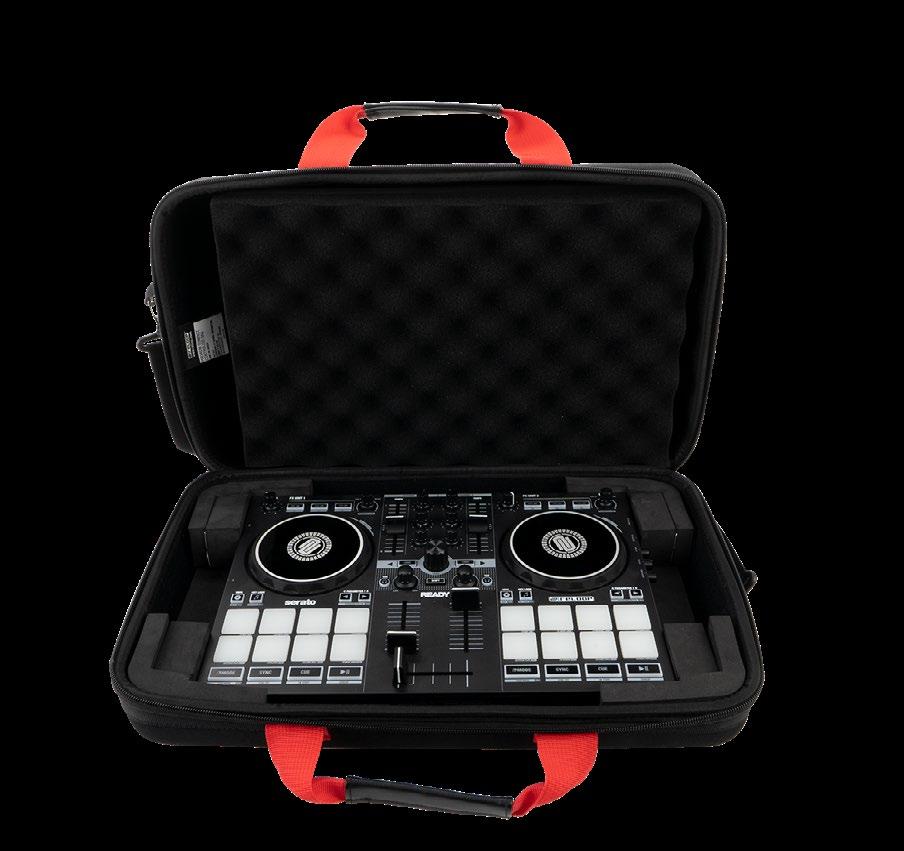
Reloop/American Music And Sound 310 Newberry Rd. Bloomfield, CT 06002 (800) 431-2609 www.reloop.com
Denon DJ, an inMusic Brand, has released the PRIME 4+ standalone DJ system. It includes a new, refined look, advanced streaming-music accessibility, new dynamic FX options, 10-percent larger jog wheel surface, and the everexpanding performance features of Engine DJ software, including standalone Stem separation. The PRIME 4+ allows instant access to over 100-million tracks across all genres. The on-board analysis buffers streaming tracks into internal memory, ensuring uninterrupted playback of streaming tracks from any wi-fi source or cellphone hotspot. Other features include: two independent microphone mixer sections; performance pad-triggered sample slots; X/Y touch FX; onboard song analysis of streaming tracks and saved media; lighting control; 26 new and updated Main FX with OLED displays and parameter controls; Sweep FX (four knob-controlled, transition-style filter knob effects); internal drive bay, plus four USB, SD and wireless Engine DJ desktop access; unlocks Serato DJ Pro and VirtualDJ compatible.


Denon DJ/inMusic 200 Scenic View Dr. Cumberland, R.I., 02864 (401) 658-3131
www.denondj.com
Mackie has introduced the DLZ Creator all-in-one podcast mixer. Complete with Mackie’s Mix Agent technology, the unit assists, automates, and guides setup for users. With its fully adaptable interface, equipped with DLZ control modes and a full studio-worthy suite of processing, the DLZ Creator puts pro-quality podcasting into the hands of users at any level. Control Modes (Easy, Enhanced, and Pro) transform the touch display from simple and intuitive to advanced and detailed, adapting to the individual user’s skill level. The Mix Agent setup assistant provides easy setup and automates functions, dialing everything in exactly where it needs to be. Pro Mode unlocks the full power of the DLZ Creator to take control and fully customize the product to get the desired sound. The AutoMix manages levels for up to four mics, so users and their guests can be heard — even when everyone speaks at the same time. The DLZ Creator produces studio-quality audio, and the Onyx80 mic preamps ensure any mic one uses will sound loud and pristine. Users can also create customized headphone mixes for guests. Mackie 16220 Wood-Red Road NE Woodinville, WA 98072 (425) 892-6500 www.mackie.com
Numark, an inMusic brand, has released the Mixstream Pro Go, a wire less, standalone, streaming DJ controller that features built-in speakers for spinning on the go. The unit integrates with Amazon Music Unlimited and other streaming services, giving DJs access to over 100 million tracks. The unit’s built-in wi-fi and on-board song analysis let play music anywhere. Other features include: Rechargeable battery; Engine DJ embedded operating system for laptopfree performances and features like embedded Sampler, Remote Library access, onboard song analysis, Touch FX, and more; Engine Lighting embedded lighting control; Computer Mode for use as a software controller; 7-inch multi-gesture highdefinition touchscreen; 6-inch capacitive-touch scratch wheels w Scratch feature for on-beat scratching; Four dual-layer performance pads on each deck; four performance mode pads on each deck (Cue, Saved Loop, Auto Loop, Roll); FX section with four effects and two toggle switches; la deck; Pitch Bend buttons and dedicated Pitch Slider; and selectable Pitch ranges of 4-, 8-, 10-, 20-, 50-, and 100-percent.
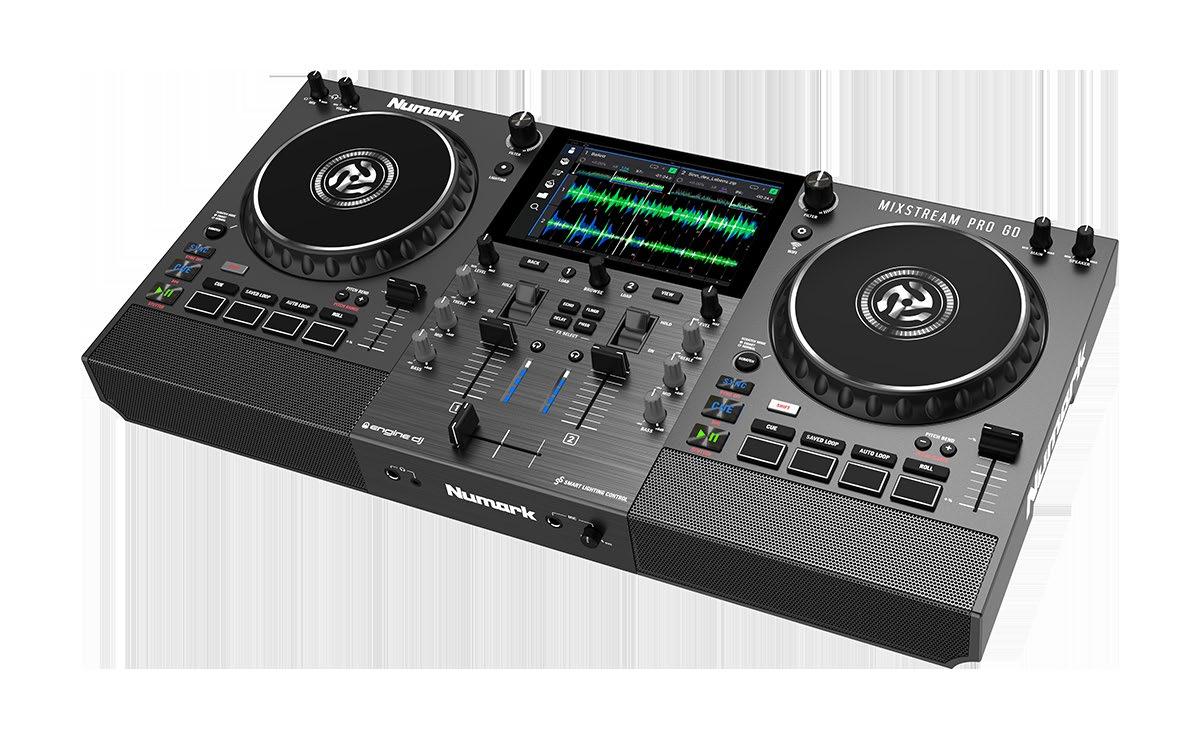

Numark/inMusic 200 Scenic View Dr. Cumberland, R.I., 02864 ( 401) 658-3131 www.numark.com
Eliminator Lighting has released the Stryker Wash, its new moving head wash fixtures. Packing in 19 potent quad color LEDs, this versatile fixture incorporates a motorized zoom function that allows for both wide color washes and narrow beams to be generated. Powerful, yet portable, the Stryker Wash is ideal for use by mobile entertainers and event productions companies as well as for permanent installation in all kinds of performance venues. The face of the Stryker Wash is covered by 19 x 12-Watt RGBW color mixing LEDs, arranged in three concentric circles, which are protected by a textured front lens. Through independent dimming control of the red, green, blue and white LED chips, a huge gamut of colors can be mixed, ranging from rich saturates to subtle pastels. The fixture also allows variable speed strobing of up to 18 flashes per second in any color.
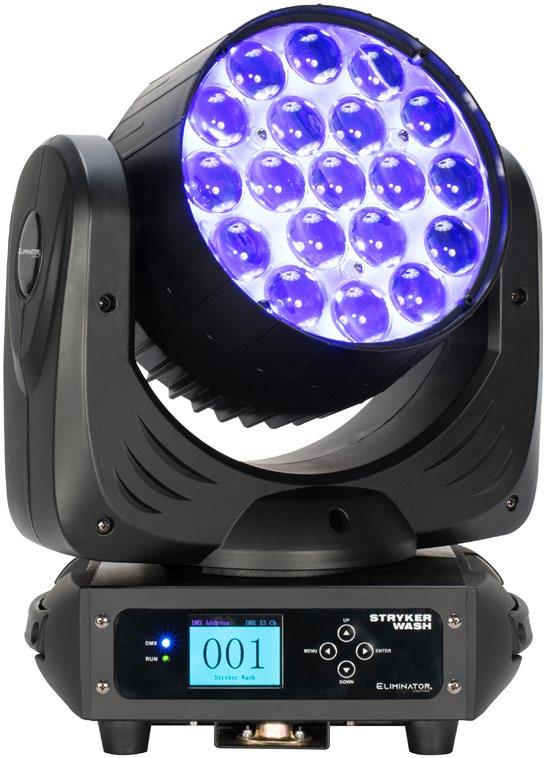
ADJ/Eliminator Lighting
6122 S. Eastern Avenue Los Angeles, CA 90040 (323) 316-9722
www.adj.com
SetFreaks is a new DJ download site that’s putting exclusivity back into music. SetFreaks allows DJs to level up their sets with exclusive limited-edition tracks from the best artists worldwide. And it places value back on music, with artists generously and speedily compensated for their creativity. Fans can build out their music collections with rare tracks, too. Each download comes complete with a personalized certificate and message from the artist. Combining a “white-label” ethos with cuttingedge technology, SetFreaks is the brainchild of Onnik Tavitian, a former DJ/producer turned full-time entrepreneur in everything music- and IP-related. Releasing techno, tech-house, house, and melodic house, with plans to expand into other genres, SetFreaks is already striking a chord with known artists and up-and-comers seeking alternative outlets for their tracks. Using bespoke technology, each SetFreaks’ download is individually encrypted with a watermark.

SetFreaks Czaar Peterstraat 1, Zaandam, 1506SK Netherlands www.setfreaks.com
Ultimate Support Systems, an ACT Entertainment brand, has released three new products that all work for podcast, recording-studio, and live applications – the VMC-T-T Venue Mic Stand, the UTH-100 Universal Tablet Holder, and the BCM-300 Broadcast Mic Stand. The VMC-T-T Venue Mic Stand’s classic barbell-style control provides torque when adjusting the lightweight, 18.75- to 31.25-inch boom. The handle provides the perfect grip for on-the-fly positioning and the quarter-turn clutch ensures quick and easy height adjustments. An ideal tool to take from studio to stage, The UTH-100 Universal Tablet Holder offers flexible support for a wide variety of tablet types and sizes. Featuring an adjustable pole clamp and flexible ball joint, the UTH-100 enables users to connect the holder to any microphone stand, while also allowing them to adjust it to any position. Perfect for radio stations and podcast studios, the updated design of the BCM-300 Broadcast Mic Stand brings fluid functionality and comfortability together in a single, sleek model. With its clamp-based mounting system and innovative cable management system, the stand can be affixed to any flat surface.
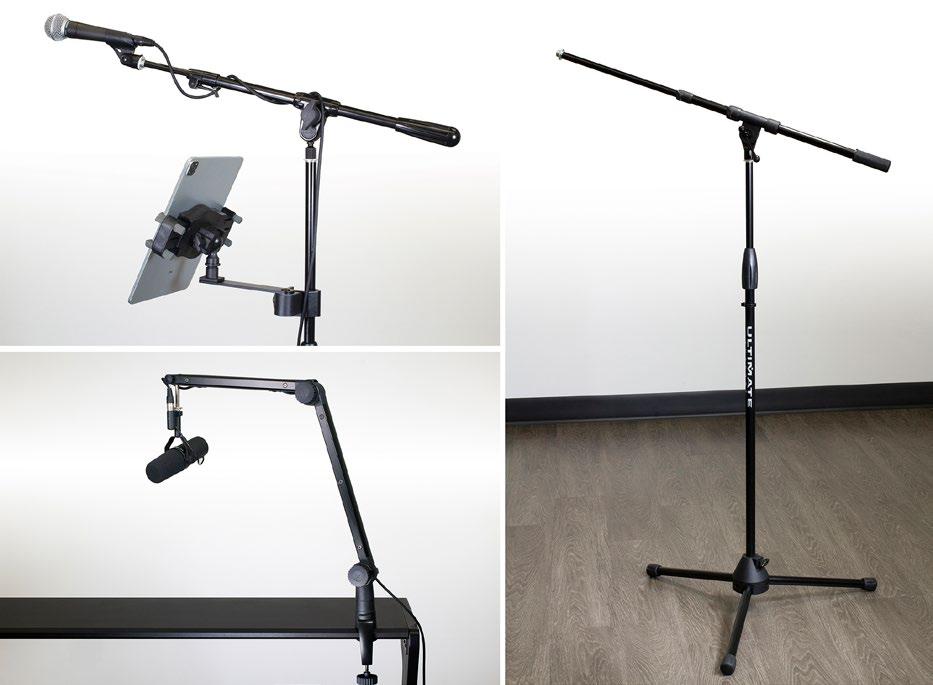
Ultimate Support Systems 3581 Larch Lane Jackson, MO 63755
(800) 525-5628
www.ultimatesupport.com
Avante Audio has released the AS8 ACDC battery-powered, column PA system. Perfect for mobile entertainers in situations where power isn’t available, the self-contained active system features Bluetooth 5.0+ connectivity, an onboard mixer and internal rechargeable Lithium-Ion battery. The system consists of an active sub enclosure, loaded with an 8-inch neodymium subwoofer, which has a 3-channel mixer built into its top panel. The sub also features a SAM (Secure Array Mount) socket which allows the two speaker columns to lock securely to the sub and to one another without risk of being toppled over. One column is loaded with six precision-aligned 2.75inch neodymium drivers, while the other serves as a spacer to lift the speaker column up to optimal height. The audio signal for the speaker column is passed through the spacer, eliminating the need for a speaker cable and ensuring a neat and tidy setup. An efficient 250W RMS (1000W peak) Class D 2-way amplifier with switching power design is built into the sub, which delivers a maximum output SPL of 116dB.

Avante Audio
6122 S. Eastern Ave Los Angeles, CA 90040 (323) 316-9722
www.avanteaudio.com
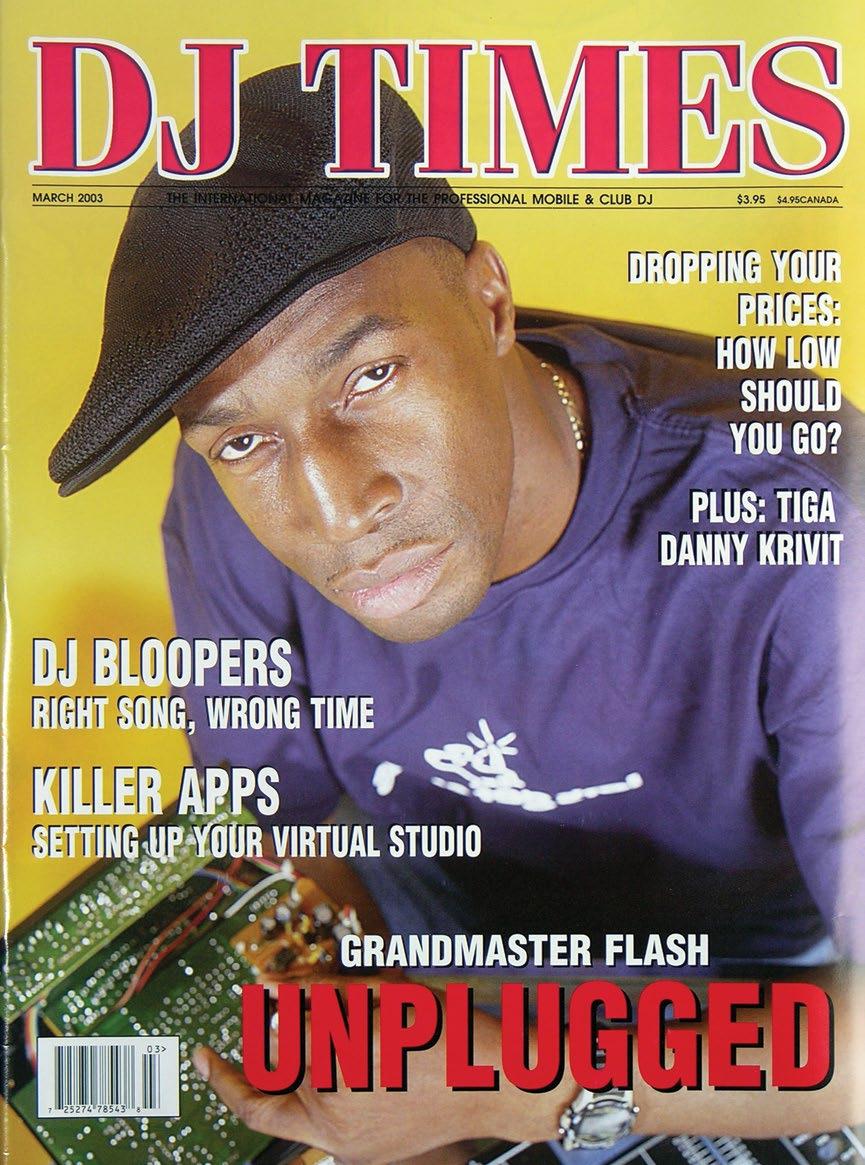
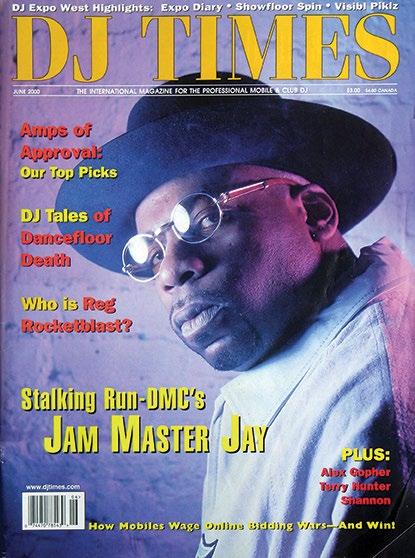

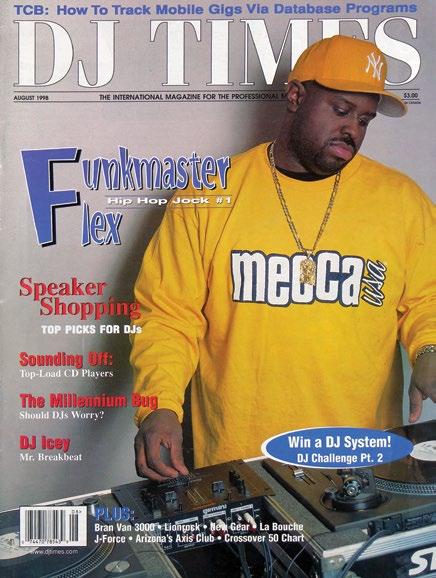






UJay is a new event-management application for DJs. A web app that allows DJs to collect song and shoutout requests, contact information, and tips from audience and event attendees using QR codes, UJay offers a new way for DJ to stay organized, build a following, and earn extra cash at each event. DJs can streamline requests because UJay’s patented QR-code integration provides custom QR codes to direct audiences to a unique landing page (no app download required) where they can request tracks, genres, shoutouts and send tips. Requests can be made anytime leading up to and throughout an event. DJs can stay organized because all audience requests are housed directly within the UJay DJ app where the DJ can see who it was requested by and who is sending tips (in case they want to play favorites). DJs can build a following because they can set up UJay to promote social-media accounts, upcoming gigs, and build SMS/email lists. UJay is available to DJs for free. In addition, UJay offers a premium version for DJs looking to increase their footprint and promote future events.
UJay LLC (612) 250-7176 www.ujayapp.com

U.K.’s Decksaver, distributed Stateside by Mixware, has released 22 new protective covers for the latest DJ gear, musical instruments, and studio products. Users of both ranges can keep their units protected and looking like new, even after years of use. To protect these valuable pieces of gear, Decksaver offers custom-molded covers that are designed to keep them safe from dust, spills, and scratches. The new covers fit the following DJ-specific products: Pioneer DJ DJM-A9 DJ mixer and the OPUS-QUAD, DDJ-FLX10 and DDJ-FLX4 DJ controllers; Denon DJ SC Live 4 controller; Rane Four controller; and Hercules DJ DJControl Inpulse T7 controller. The new covers fit the following musical instrument/studio products: Akai MPK Miniplay MK3; Novation 49SL MK3, Launchkey 37 MK3 and Summit; Arturia MiniFreak; 1010music Nanobox units; 4MS Pod48x and Pod64x enclosures; Solid State Logic SSL12 interface; Sonicware SmplTrek sampler; and Loupedeck Live S.

Decksaver/Mixware 11070 Fleetwood St., Unit F Sun Valley, CA 91352 (818) 578-4030 www.mixware.net
Waves Audio has introduced StudioVerse, an AI-powered system for plug-in chains. StudioVerse is now available in Waves Creative Access, the company’s new subscription service, which includes the entire Waves plug-in catalog and is now the exclusive way to get Waves plug-ins. StudioVerse is a vast online network of plug-in chains, available directly in your DAW. It includes thousands of presets for entire plug-in chains, with easy Musical AI search. Each chain is like a shortcut to a professionally produced or mixed track. The chains are created by industry-leading producers and mixers – plus hundreds of other top pros and expert creators. StudioVerse is also an open platform, where anyone can upload and share chains at any time, so the vast number of mixing chains available in StudioVerse is ever-growing. StudioVerse’s Musical AI search engine recommends the best chains for your specific tracks. All you need to do is click the “Scan” button: StudioVerse’s musical machine learning engine will learn your track’s “Audio ID” and instantly recommend mixing chains matching your unique sonic fingerprint.
Waves Audio 2800 Merchant Dr. Knoxville, TN 37912 (865) 909-9200 www.waves.com
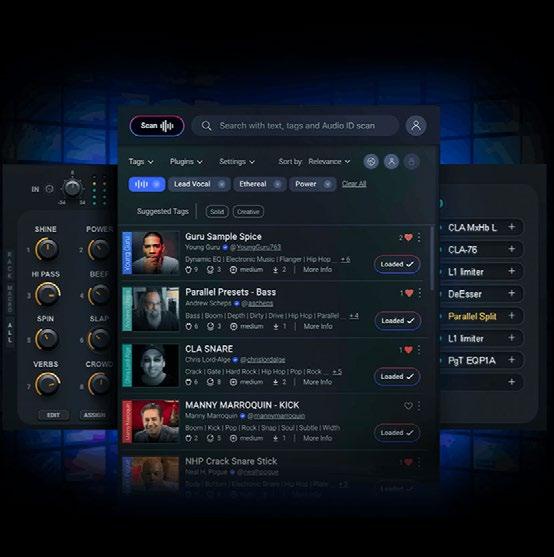
YOUTH MUSIC PRODUCTION AND DJ PROGRAM ON A NEW TRACK REENTRY MENTORING PROGRAM PRISON ELECTRONIC MUSIC PROGRAM
giveabeat.org giveabeat igiveabeat L
Be a champion for the transformative power of music while promoting social justicebecome a Give a Beat member today!
The I Give a Beat Patreon Membership offers an opportunity to support our mission to use the power of music as a pathway to healing and opportunity for those impacted by the criminal justice system while also receiving valuable perks.
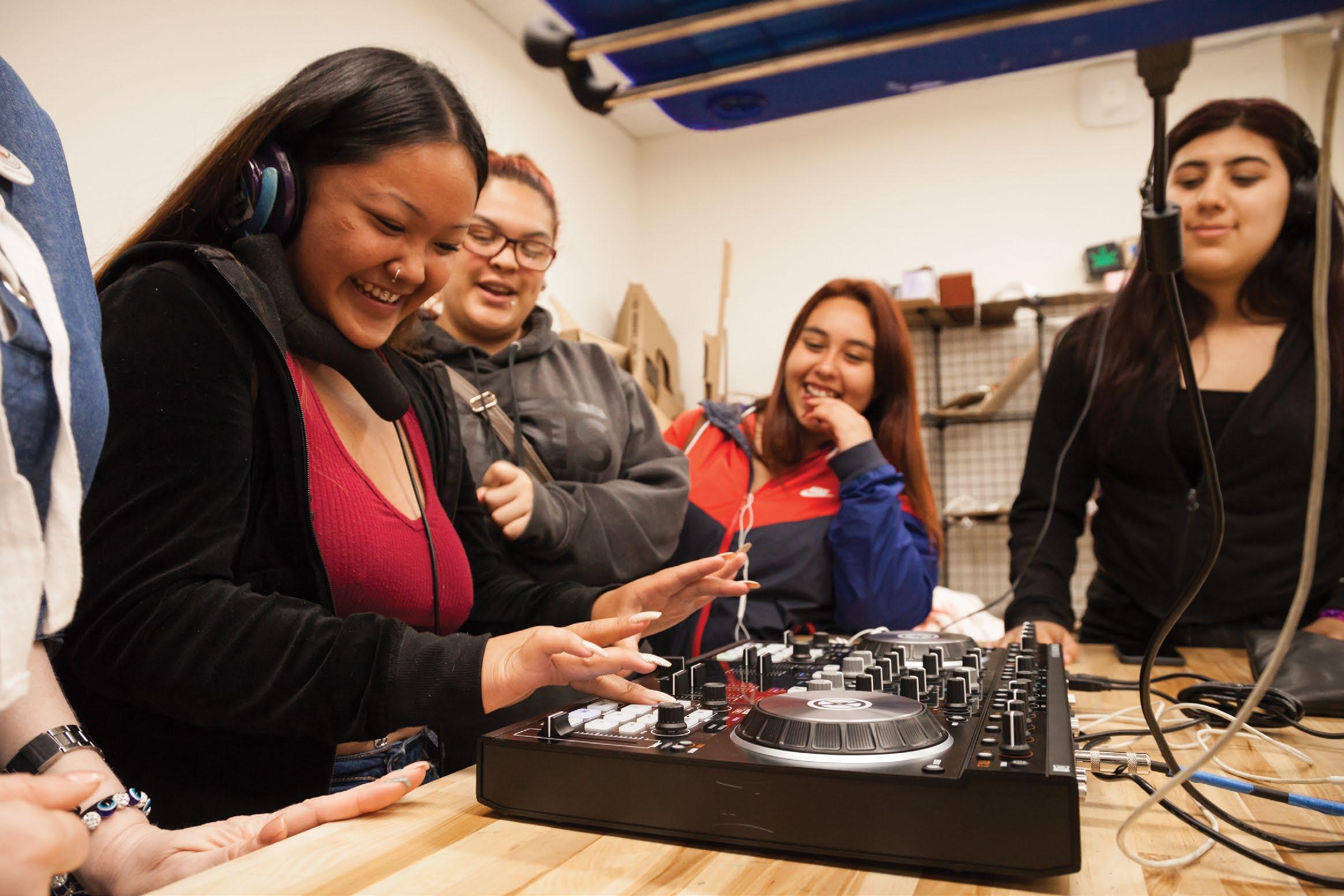
Benefits include discounts and subscriptions to Ableton, Beatport LINK, IO Music Academy, OM Records, ROSTR, great swag and more!
giveabeat.org/PATREON
“Happy People”
Sonic Soul Orchestra feat. Phillip Ramirez
Tinted
Still on a roll, the Sonic Soul Orchestra hooks up with falsetto vocalist
Phillip Ramirez for an uplifting track for summer. Demarkus Lewis and Jay Vegas provide alternative takes, with the latter supplying the pick of the bunch for me. Sweet.
–
Curtis Zack“Keep Talking”
Duwayne Motley feat. Aleysha Lei
Peppermint Jam
U.S. meets U.K. meets Germany with this bright, pumping Peppermint Jam offering. An uplifting piano hook blended with the super-soulful vocals of Aleysha Lei help create a winning dancefloor formula.
– Curtis Zack
“Patchouli Brothers Edits” EP
The Patchouli Brothers Razor n Tape
The Canadian disco duo makes its debut on the always-on-point label, Razor n Tape. Digging deep for this four-tracker, the team delivers bomb after absolute bomb here. “Emotional Dancing” is the personal favorite, but you can’t go wrong with the other three – just play them all.
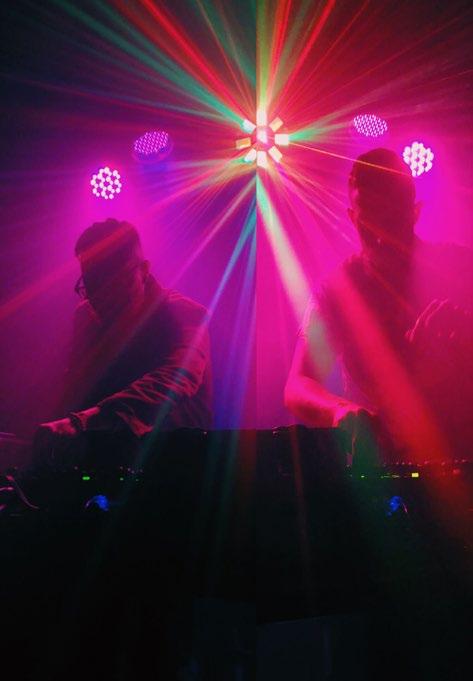
– Curtis Zack
Michael Gray feat. Tatiana Owens
Sultra
The hottest man in house music at the moment – and one half of Full Intention –returns with one of his best tracks yet on his home imprint, Sultra. With a sublime vocal from Owens and first-rate production from Gray, this smooth, sweeping number has all the ingredients to make it one of the biggest tracks of the year.


 – Curtis Zack
– Curtis Zack
“Touch Want Feel”
Eli Escobar Night People
Escobar goes for a decidedly ’80s feel on this peppery four-tracker – overall, it’s quite convincing. From the jump, you get the lascivious electro jam, “Phreek,” with Amanda Blank on the mic dropping the dirt. The title track sports a nervy rat-a-tat rhythm that melds with its deep-house flourishes in an oddly compelling way. Smooth dancefloor fave “Deep Down Inside” (with Stephen Klavier’s vocal) pumps and percolates with purpose – and don’t sleep on the groovy dub version. Meanwhile, the sizzling “Body Free” ramps up the heat even further. Retro and raw.
– Jim Tremayne“Hot For Love”
Jung Soul feat. Louise Marshall
Midnight Riot
Midnight Riot, the U.K.’s premier nudisco label, delivers the goods yet again with this latest offering. With its driving boogie bassline backed by the superb vocals of Marshall, this shouts summer from beginning to end. Retro and wonderful.


– Curtis Zack
“Tokyo Nights”
Narda
Cruise Music
Sampling an obscure Japanese disco number from the late-’70s, Narda’s new release from Cruise Music is aimed firmly at the dancefloor. Strings and brass combine with the Japanese vocal for an uplifting and completely unique cut.
– Curtis Zack
“Ayo”
Jay B McCauley feat. The Trueheart

Choir
Unquantize
A quality Afro-house cut here from the DJ Spen stable, featuring The Trueheart Choir from Nigeria. On the remix tip, Mijangos keeps a similar, percussive vibe, while taking the track a bit deeper on the house side. Meanwhile, Col Lawton takes the cut in a more snappy, jazzhouse direction. Quality all around.
– Curtis Zack
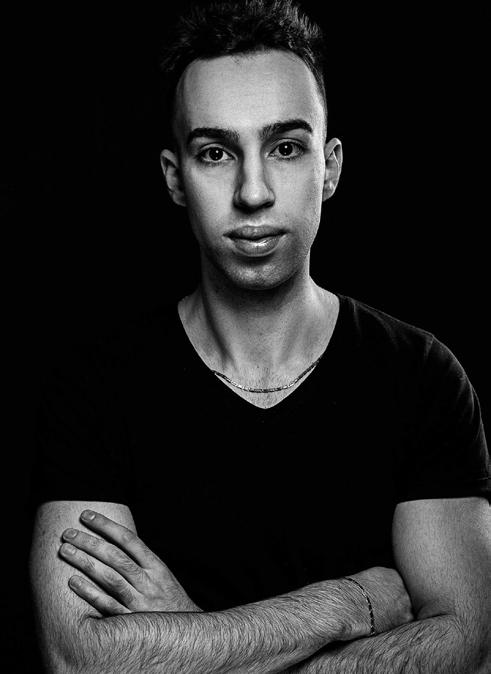
“Funk Mansion”

Hiva
Salted Music
Super-funk from Serbia is the order of the day on the latest from Miguel Migs’ longtime imprint. With the title track and B-side “Agogo,” DJs get two clubready tracks flaunting jackin’, funky, and groovy elements in equal amounts. Nasty stuff.
Purple Disco Machine
Columbia Local
On this, another bumpin’ dancefloor bomb from the recent Grammy winner, PDM delivers more polished jewels from the past. With tasty samples from First Choice and Company B, PDM (aka Tino Piontek) crafts a rollicking groove/hook combo into an upbeat earworm that won’t let go.
Narda – Curtis Zack Hiva1 David Guetta, Anne-Marie
& Coi
■ DJ Sticky Boots The HyperMiXx Syndicated
■ The Dance Environment What’s In-Store Music Los Angeles, CA
■ Manny Esparza Nexus Radio Chicago,IL

■ Howard HK Kessler In The Mix With HK Syndicated
■ Brian Stephens Mixxmasters Lithonia,GA
■ Randy Schlager KNHC 89.5FM Seattle, WA

■ DJ Ilan Fong Multiple Pod Casts Columbus, OH
■ Michael Cerchiai House Of Pride Radio San Francisco, CA
■ DJ Spawn Mix 93 FM Los Angeles, CA

■ Chris Egner Victors Milwaukee, WI
■ Alan Chasen OMAP Washington, DC
■ Rafy Nieves Clubs / Radio San Juan, PR
■ Mike Rizzo Clubs / Radio Tri State Areas
1 Teria Morada & A. Mendez Ft Choclair Bon Voyage Underbite Records
2 Nino Segarra feat Santa La Salsera Plan Divino Opus Factory
3 DJ Swagrman feat Yubeili, Oplus HYM Duncan Group Ent.
5
Domenic Marte Vete Direct Balance
Most Added Tracks
2 Elvis Crespo, feat Grupo Fueggo Bebe Dame Flash Music
3 Banda Carnaval Me Perdí De Un Amor Disa
4 Limi-T 21 Me Quedo LT21
5 La Arrolladora Banda El Limón De Memoria Me Las Se Disa
■ Latinos Unidos Record Pool
■ Salsamania Latin Record Pool
■ Lobo/Bass Record Pool
■ North East Record Pool
■ Mixx Hitts Record Pool
■ Ritmo Camacho Record Pool
Ritmo Internacional Record pool
DJ Latinos Record Pool
MassPool
Record Pool Latino
Latin
All In Music Pool CLUB
Beat Chicago